take a trip with
KARINE ELUDUT
Bonjour, et bienvenue en France!
As a French native, French cuisine is an integral part of my life. We French people have a deep love for food; we love to talk about it, prepare it, and most importantly, eat it. We take pride in being both "gourmands" and "gourmets." In this series, we will embark on a culinary journey across France, stopping in different regions to explore their iconic and most popular dishes, commonly found in French households. France is a diverse country, and so is its cuisine. So, fasten your seatbelts and get ready to embark on this gourmand and gourmet Tour de France with me! — Karine
Please enjoy this series by Karine Eludut. Food photography on this page is ©Karine Eludut.
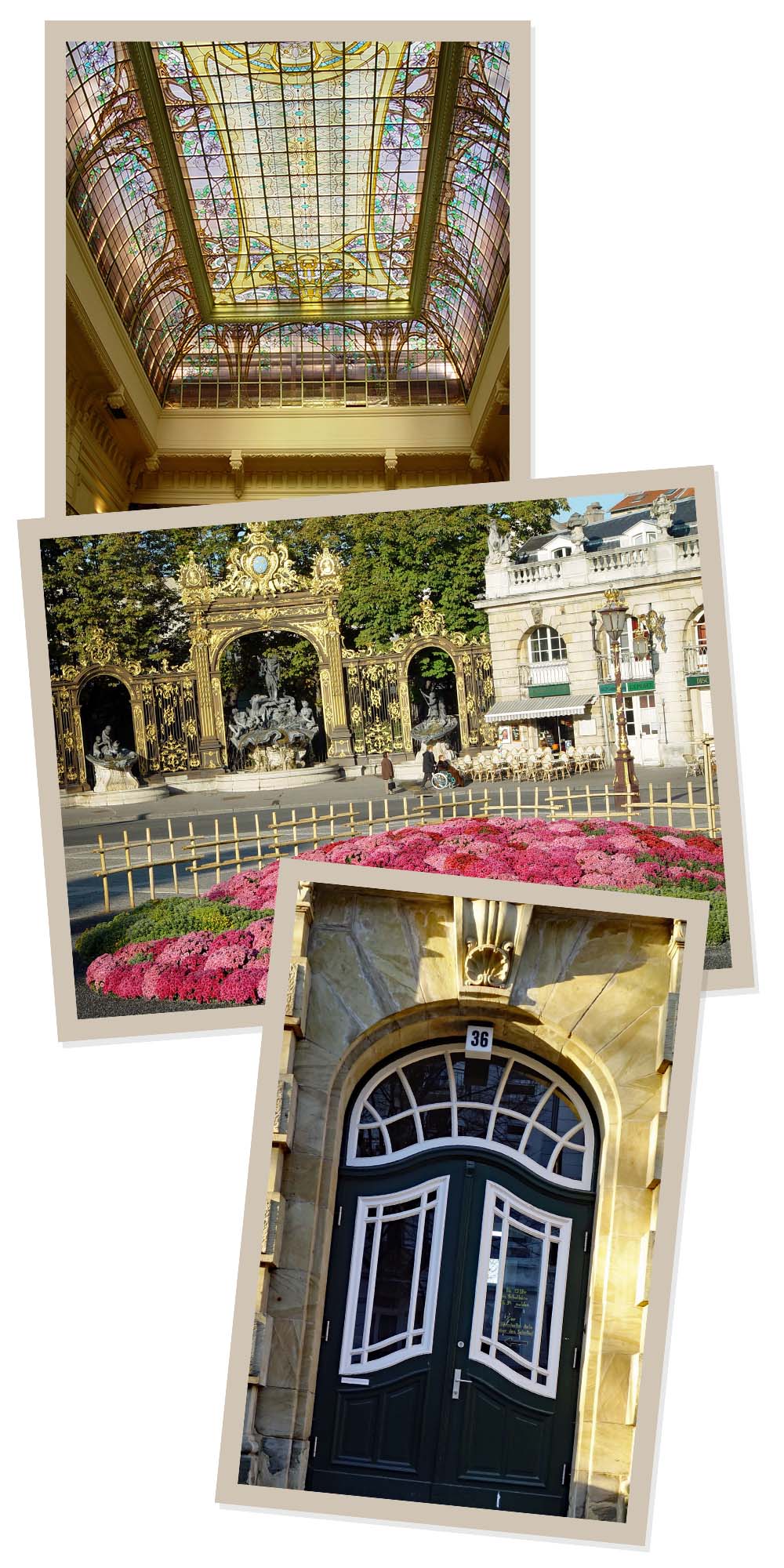
"Nancy, Nancy: trois minutes d’arrêt!” (“Nancy, Nancy: three-minute stop!”) —the lively announcement echoing through the train's speakers as it gracefully pulled into Nancy gare station. Growing up, I always thought my hometown was beautiful, but it wasn't until I ventured out that I realized its rich tapestry of history.
Walking through Nancy is akin to flipping through the pages of a captivating history book, with each step revealing a new chapter. From the charming medieval streets with their worn cobblestones to the sleek modern avenues, the city seamlessly weaves together past and present.
Now, picture this: you're chilling on the terrace of Café du Commerce, sipping on some tea or maybe a fancy latte, all while basking in the splendor of Place Stanislas. This magnificent square, commissioned by the exiled Polish King Stanislas, is the beating heart of Nancy. Designed in the 18th century by the visionary architect Emmanuel Héré under the commission of King Stanislas, it's a living testament to the city's royal past and artistic prowess. With its City Hall, Museum of Fine Arts, enchanting fountains, and lively cafés and restaurants, it's no wonder Place Stanislas has earned UNESCO World Heritage status - its architectural splendor and historical significance are simply unmatched.
And then there's the enchanting Art Nouveau, a movement that found its epicenter in Nancy during the early 20th century. Walking into Crédit Lyonnais, housed within a historic building, I'm always in awe of the intricate glass ceilings—a testament to the city's artistic flair and innovation. Nancy became a playground for renowned figures like Émile Gallé, and its streets are peppered with architectural gems like the Villa Majorelle.
But perhaps most emblematic of Nancy is its symbol, the thistle, with the motto "Qui s’y frotte, s’y pique" (He who touches it, gets pricked). It's a fitting metaphor for a city that's both beautiful and formidable, inviting exploration yet retaining an air of mystery and resilience.
Lorraine, nestled in northeastern France, is a region brimming with history, culture, and natural beauty. While Nancy, its capital, shines brightly with its architectural wonders and culinary delights, there are other gems waiting to be discovered across the region. Here are some additional places worth visiting:
Metz: As one of the major cities in Lorraine, Metz boasts a rich tapestry of history and modernity. Its stunning Gothic cathedral, Saint-Étienne de Metz, is a marvel of medieval architecture, while the Centre Pompidou-Metz showcases contemporary art against a backdrop of innovative design. Stroll along the banks of the Moselle River, explore charming neighborhoods, and immerse yourself in the vibrant atmosphere of this dynamic city.
Les Vosges: Escape to the tranquil beauty of Les Vosges, a low mountain range that stretches across Lorraine. Here, outdoor enthusiasts can indulge in a plethora of activities year-round. In the winter, hit the slopes at one of the ski resorts nestled amidst snow-capped peaks. During the warmer months, hike through lush forests, paddle across crystal-clear lakes, or simply soak in the breathtaking scenery. With its rolling hills and serene landscapes, Les Vosges offers a perfect retreat for nature lovers and adventure seekers alike.
Baccarat: Step into a world of elegance and craftsmanship in the charming town of Baccarat. Renowned for its exquisite crystalware, Baccarat has been synonymous with luxury and refinement for centuries. Visit the Maison de la Cristallerie to witness master artisans at work, marvel at the shimmering displays in the crystal museum, and perhaps even take home a timeless piece of Baccarat crystal as a souvenir. A visit to Baccarat is a journey into the artistry and heritage of fine craftsmanship.
- QUICHE LORRAINE - a savory tart
- Paté Lorrain - a savory dish made with chopped pork and veal flavored with white wine and baked in puff pastry
- Macarons de Nancy - which should not be confused with the world-famous Parisian macarons, Nancy's macarons are typically single-shelled almond cookies, while Parisian macarons are sandwich-like cookies made with almond flour
- Madeleines de Commercy - the little sponge cakes with their distinctive shell-shape
- Dragées de Verdun - bite-size confectionery composed of almonds coated in sugar and honey
- Bergamotes de Nancy - candies flavored with bergamot (a citrus fruit) essential oils
Quiche Lorraine is a rustic and classic French dish renowned for its simplicity, yet rich and indulgent flavor. Originating from the Lorraine region in northeastern France, this savory pie-like dish has gained widespread popularity both in its home country and internationally.
The basic ingredients of Quiche Lorraine include eggs, cream, and lardons (strips of bacon). These ingredients are combined and poured into a pastry crust, typically made with flour, butter, a pinch of salt and pepper, and a dash of nutmeg. The filling is then baked until it sets, resulting in a golden, creamy, and satisfying dish. Traditional quiche Lorraine does not have cheese.
One of the distinctive features of Quiche Lorraine is its deliciously simple flavor profile. The richness of the eggs and cream is balanced by the saltiness of the bacon or lardons. The pastry crust provides a buttery and flaky base that complements the creamy filling perfectly.
Quiche Lorraine is incredibly versatile and can be served hot or cold, making it suitable for any occasion. It is often enjoyed as a hearty breakfast or brunch dish, but it also makes for a delightful lunch or dinner option when paired with a fresh salad or vegetables. Its popularity as a party or picnic food further attests to its widespread appeal.
Over the years, various adaptations of Quiche Lorraine have emerged, with some incorporating additional ingredients such as cheese, onions, mushrooms, or spinach. However, the traditional recipe remains a timeless favorite, cherished for its comforting flavors and straightforward preparation.
In addition to its delicious taste, Quiche Lorraine holds cultural significance as a symbol of French culinary heritage. Its enduring popularity around the world reflects the universal appreciation for the simple yet satisfying pleasures of good food. Whether enjoyed as a cozy meal at home or as part of a festive gathering, Quiche Lorraine continues to delight taste buds and bring people together through its timeless appeal.
Quiche Lorraine is a rustic and classic French dish renowned for its simplicity, yet rich and indulgent flavor. Originating from the Lorraine region in northeastern France, this savory pie-like dish has gained widespread popularity both in its home country and internationally.
around the QUICHE LORRAINE
- Salmon Spinach Quiche
- Roasted Vegetable Quiche
- Asparagus Quiche
with QUICHE LORRAINE
- Riesling (Alsace white wine)
- Beaujolais (red wine)
NORTHWESTERN FRANCE
Our second stopover will be Quiberon, located in Brittany - northwestern France, which is famous for its Caramel au Beurre Salé.
I chose this destination to be our second stop because my family from my father’s side is from nearby.
Quiberon, France
Recipe: Crêpes au caramel au beurre salé
Quiberon, nestled on Brittany’s southern coast, boasts stunning beaches, rugged cliffs, and a charming town center. Whether you’re exploring historic sites, indulging in fresh seafood, or soaking up the sun, Quiberon offers a captivating coastal escape.
How about spending a day in Quiberon together? We’ll rise early to witness the stunning sunrise over the Atlantic Ocean, immersing ourselves in the salty air and the symphony of birdsong. Afterward, let’s meander along the coastal trails, surrounded by the captivating beauty of bunny tails plants.

As breakfast beckons, we’ll make a beeline for the nearest boulangerie to relish a divine Kouign Amann paired with our favorite coffee. A stop at the farmers’ market is essential, brimming with stalls offering fresh fruits, vegetables, seafood straight from the fishermen, charcuterie, cheeses, local specialties, and crafts.
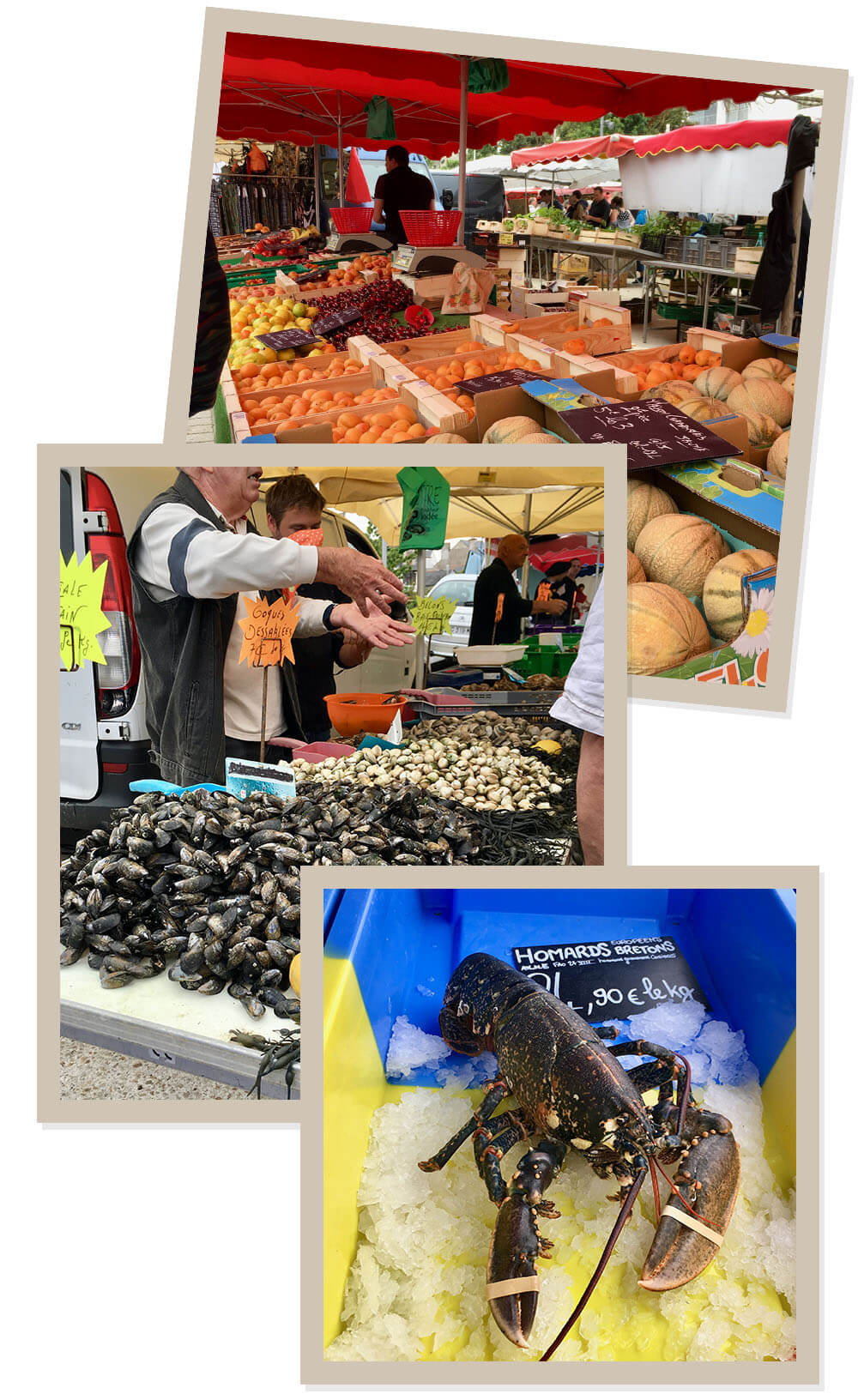
Amidst the city center’s quaint streets, we’ll visit Chocolaterie Henri LeRoux to indulge in some delectable Caramel au Beurre Salé candies, invented by the renowned Henri LeRoux himself. Before renting bikes, let’s enjoy lunch at one of the brasseries overlooking the stunning beach. Who’s up for a dozen oysters and a savory buckwheat crêpe?
Next, we’ll bike along the west coast of the Quiberon Peninsula (Route Côtière), where rugged cliffs overlook the Bay of Biscay, offering breathtaking views. Time to unwind! Let’s treat ourselves to a rejuvenating algae body wrap and a massage at the thalasso therapy center.
For dinner, we’ll reserve a table at a restaurant in the Port Maria neighborhood to witness the mesmerizing sunset. Our meal will feature sumptuous shellfish, fresh fish, and, of course, a delectable sweet crêpe for dessert.
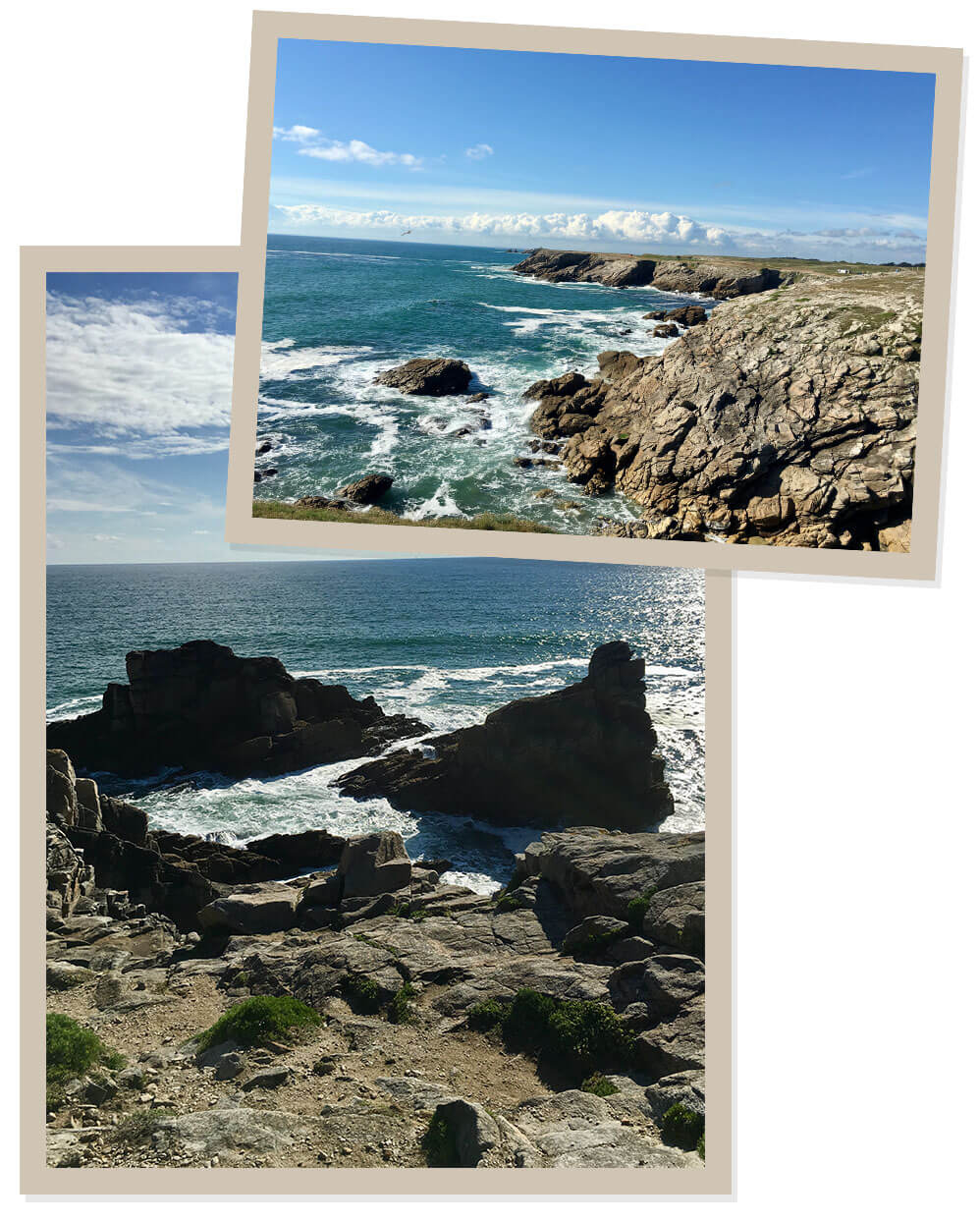
If not too tired, let’s cap off our day with some time in the Casino for a bit of fun and excitement. Who’s in for this unforgettable Quiberon adventure?
Brittany is a treasure trove of attractions waiting to be explored! Among the multitude of destinations, I’ve handpicked three worth your time, each with its own unique charm, all conveniently located near Quiberon.
Belle-Ile: Belle-Île-en-Mer, commonly referred to as Belle-Île, is a picturesque island located off the coast of Quiberon (14 km/9 miles). Known for its stunning coastal landscapes, rugged cliffs, and sandy beaches, Belle-Île is a popular destination for tourists seeking natural beauty and outdoor activities such as hiking, cycling, and water sports. The island also boasts charming villages, historic sites, and cultural attractions.
Carnac: Carnac is a commune located in the Morbihan department in Brittany, France, known for its impressive megalithic monuments. These ancient stone alignments, comprising thousands of standing stones, are among the largest such collections in the world and are a UNESCO World Heritage site. Carnac is also a popular seaside resort, attracting tourists with its sandy beaches, charming village atmosphere, and proximity to other Breton attractions.
Vannes: Vannes is a charming medieval city , famous for its well-preserved historic center, cathedral, and bustling port. It’s a vibrant cultural hub and gateway to exploring the southern coastline of Brittany.
- CRÊPES
- CARAMEL AU BEURRE SALÉ
- Kouign Amann - Kouign amann is a delicious Breton pastry made from bread dough containing layers of butter and sugar, similar to puff pastry or croissant dough, but with additional sugar folded in during the process, creating a caramelized, crispy crust. The name “kouign amann” comes from the Breton words for “cake” and “butter.”
- Far Breton - Far Breton is a dense, custard-like cake made with eggs, flour, sugar, and milk or cream, flavored with vanilla and often infused with rum-soaked prunes or other dried fruits. The batter is poured into a buttered dish and baked until set, resulting in a smooth, creamy texture with a slightly caramelized crust. It’s a comforting and delicious treat that showcases the simple yet rich flavors of Brittany cuisine.
- Buckwheat galettes (crêpes) - Buckwheat galettes are traditional Breton savory crepes made from buckwheat flour, water, and salt. They are typically filled with ingredients such as ham, cheese, eggs, or vegetables, folded into a square shape, and enjoyed as a delicious and hearty meal.
- Sablés bretons (cookies) - Sablés Bretons are classic French butter cookies originating from Brittany. They are characterized by their rich, buttery flavor and crisp texture, often with a slightly sandy or crumbly consistency. Sablés Bretons are typically made with simple ingredients including butter, sugar, flour, and egg yolks, and are enjoyed as a delightful treat with tea or coffee.
- Cotriade - Cotriade is a traditional Breton fish stew made with a variety of fresh fish and shellfish, simmered together in a flavorful broth with aromatic vegetables and herbs. It’s a hearty and comforting dish that showcases the rich flavors of Brittany’s coastal cuisine.
Crêpes, those thin and delicate French pancakes, have captured hearts and palates worldwide with their irresistible combination of versatility and deliciousness. Originating from Brittany, France, these delectable treats have become a culinary canvas for a wide array of flavors and textures, earning them a well-deserved place in the pantheon of beloved French foods.
What sets crêpes apart is their sheer adaptability. They can be filled or topped with just about anything, from the simplest of ingredients to the most luxurious delicacies, making them suitable for any occasion or craving.
For a classic and timeless treat, a light dusting of sugar and a squeeze of lemon juice is all it takes to transform a humble crêpe into a mouthwatering delight. Or, indulge your sweet tooth with decadent combinations like rich chocolate sauce and fresh strawberries, velvety hazelnut-chocolate spread and bananas, or tangy raspberry coulis and whipped cream. And of course with Caramel au Beurre Salé.
If savory is more your style, crêpes are equally versatile in savory applications. A filling of ham and gooey melted cheese, perhaps with a touch of béchamel sauce, creates a satisfying meal reminiscent of the iconic croque-monsieur. For a lighter option, fill your crêpe with spinach, mushrooms, and gruyere cheese for a sophisticated vegetarian option.
From breakfast to dessert, crêpes never fail to impress. Their elegance and simplicity make them a staple of French cuisine, enjoyed at quaint street-side crêperies, cozy bistros, and fine dining establishments alike. Whether you’re savoring them on a leisurely weekend morning or indulging in a late-night snack, crêpes are a delicious reminder of the beauty of simplicity in cooking.
Caramel au beurre salé, or salted butter caramel, is a beloved French confection known for its rich and indulgent flavor. Made by caramelizing sugar and combining it with butter and cream, this sweet and savory sauce is often used as a topping or filling for desserts such as crepes, cakes, and ice cream. Invented by Henri LeRoux, it’s a cherished treat in France and beyond. To enhance its flavor, it’s often sprinkled with fleur de sel, adding a delicate touch of saltiness to complement the sweetness of the caramel.
Crêpes are incredibly thin and delicate French pancakes, known for their versatility and deliciousness. These delectable treats can be filled or topped with a wide range of sweet or savory ingredients, making them a culinary canvas for a variety of flavors and textures. Whether served with a simple drizzle of lemon and sugar, decadent chocolate and strawberries, or savory ham and cheese, crêpes are a delightful addition to any meal, from breakfast to dessert. Their elegance and simplicity make them a beloved classic in French cuisine and beyond.
around the CRÊPES
- Crêpes aux champignons (Crêpes filled with a mushroom sauce)
- Crêpes with sautéed caramelized apple
- Crêpes filled with goat cheese and bacon strips
with CRÊPES AU CARAMEL AU BEURRE SALÉ
- Cidre (Apple cider) alcoholic or non-alcoholic
- Tea/coffee
- Local beer
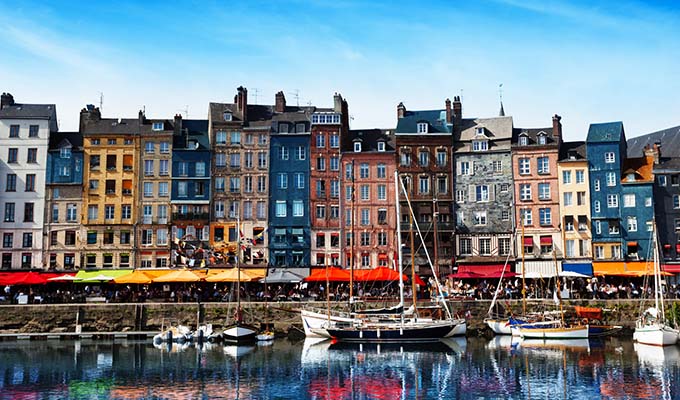
NORTHWESTERN FRANCE
Let’s stay on Northwestern France for our third stopover which is Honfleur located in Normandy. Honfleur is famous for its seafood and shellfish.
I chose this destination to be our third stop because Honfleur is one of the most exquisite little port town, which was, and still is, affectionate by artists.
Honfleur, France
Recipe: Mouclade au Safran (Saffron Mussels)
Honfleur, a picturesque coastal town reminiscent of scenes from a postcard, exudes an irresistible allure, drawing visitors with its promise of winding, cobblestone streets, bustling harbors dotted with colorful boats, and an abundance of culinary delights, particularly its renowned seafood offerings.
Remembering my first encounter
My first time in Honfleur was like stepping into a painting brought to life. From the moment I set foot in this picturesque coastal town, I was enchanted by its old-world charm and captivating beauty. The cobblestone streets, lined with centuries-old buildings adorned with colorful shutters and blooming flowers, whispered tales of a bygone era waiting to be explored.
As I wandered through the narrow alleyways of the old town, my senses were overwhelmed by the sights, sounds, and smells of this vibrant community. The lively bustle of the Vieux Bassin, the old port brimming with fishing boats and bustling cafés, filled the air with the melodious clang of bells and the salty tang of the sea. Each corner I turned revealed a new wonder: the towering spires of Saint Catherine's Church, the tranquil beauty of the Jardin des Personnalités, and the quaint charm of hidden courtyards tucked away from the main thoroughfares.
Of course, no visit to Honfleur would be complete without indulging in its culinary delights. From the freshest seafood straight from the ocean to decadent pastries and creamy cheeses, every meal was a feast for the senses, savored against the backdrop of sweeping views of the harbor and the gentle lapping of waves against the shore.
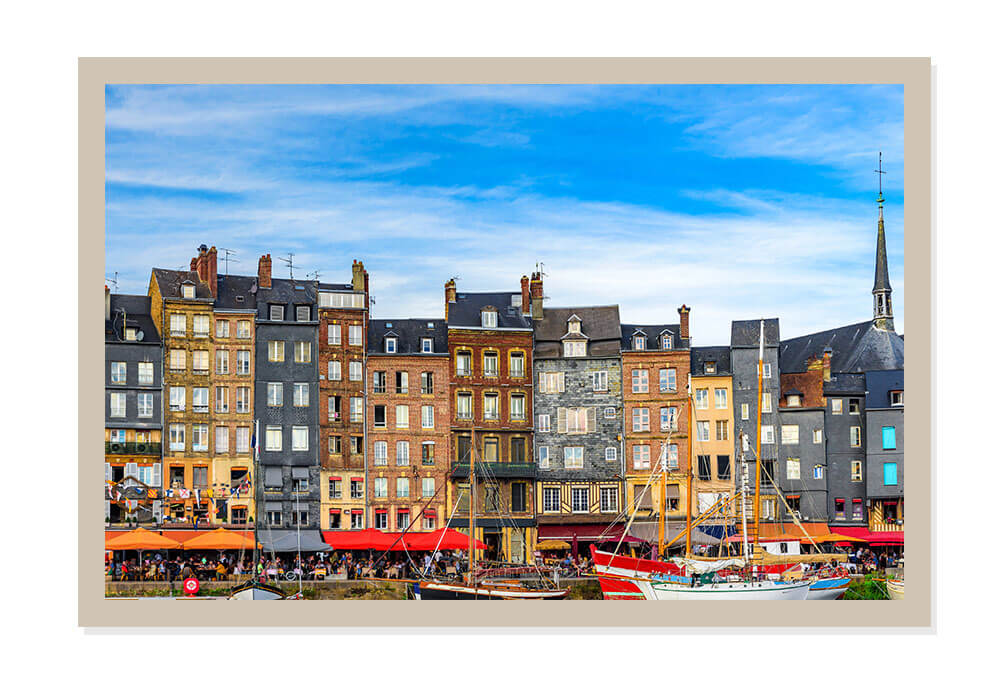
As the sun dipped below the horizon, casting a warm glow over the town, I found myself reluctantly bidding farewell to Honfleur, knowing that I had experienced something truly magical in this timeless corner of the world. But as I turned to leave, I couldn't help but smile, knowing that I would carry the memories of my first visit with me forever. In that moment, I could almost feel the presence of Claude Monet, the famous painter who found inspiration in Honfleur's beauty, immortalizing the scene with his signature strokes, adding an extra layer of enchantment to an already unforgettable day.
Normandy captivates with its scenic coastal landscapes, historic landmarks, and rich culinary heritage. From the iconic white cliffs of Étretat to the historic beaches of the D-Day landings, Normandy offers a captivating blend of natural beauty and cultural significance.
Deauville: Deauville, a glamorous seaside resort in Normandy, France, is known for its wide sandy beach famous for its colored parasols, historic wooden boardwalk, and upscale ambiance. Key attractions include the Deauville Casino, the annual American Film Festival, and a vibrant equestrian culture with horse races and polo tournaments. The town also features high-end shopping, gourmet dining, and iconic grand hotels like Hôtel Barrière Le Normandy. Deauville's mix of natural beauty, cultural richness, and luxury makes it a prime destination for discerning travelers.
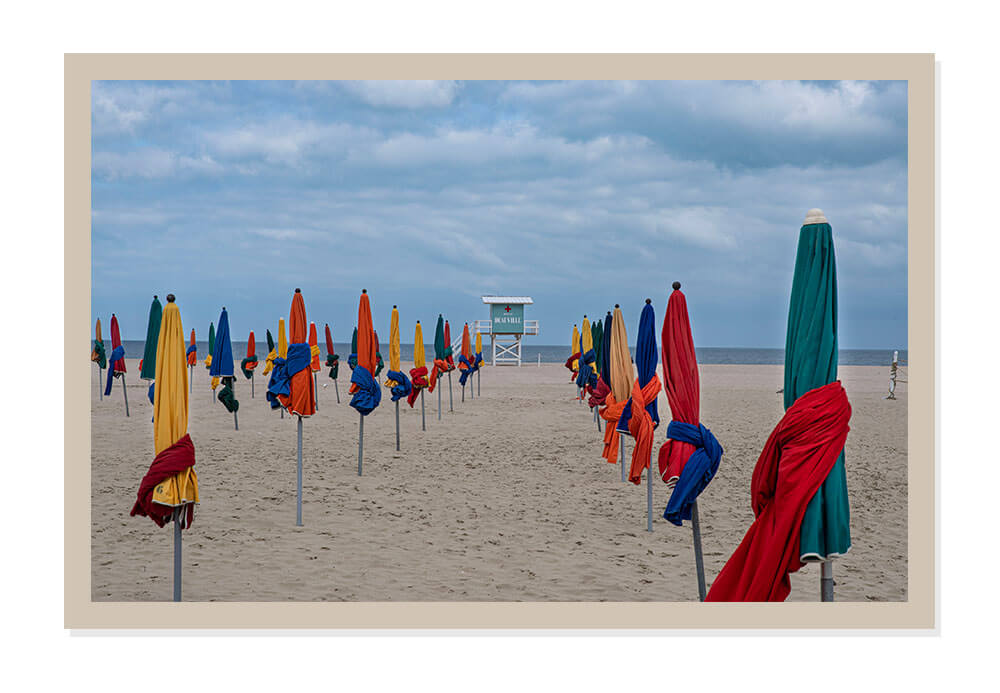
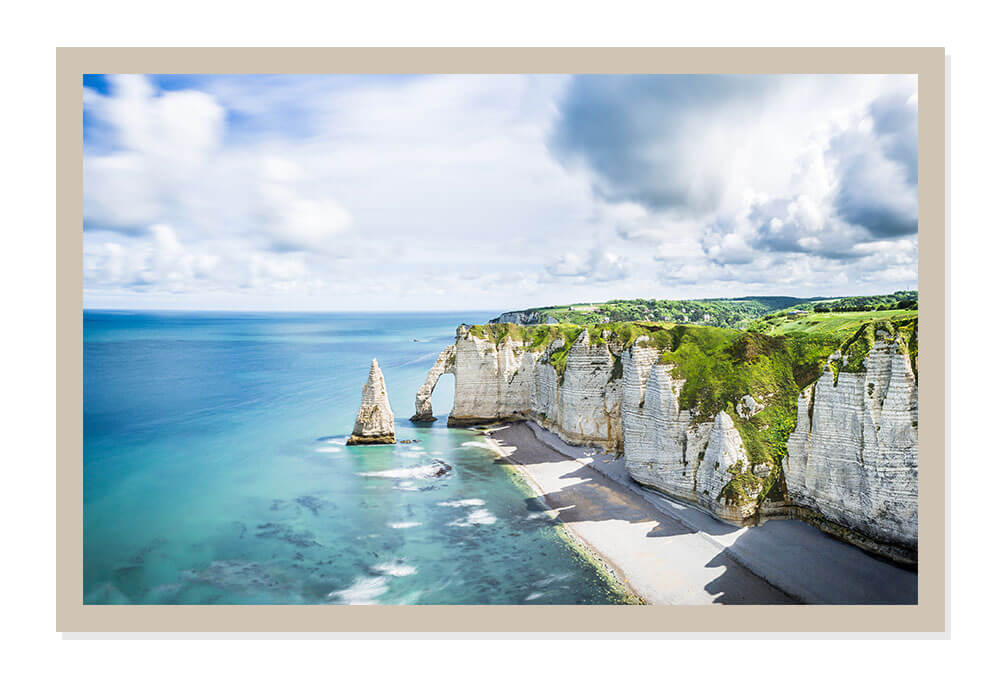 Normandy countryside: The Norman countryside in northwestern France is a picturesque region known for its rolling green hills, historic villages, and rich cultural heritage. Highlights include the charming "bocage" landscape, quaint villages like Beuvron-en-Auge and Camembert, historic châteaux such as Château de Carrouges, and the scenic Cider Route with its apple orchards and local ciders. The area is also significant for its D-Day landing beaches and renowned for its culinary delights, including Camembert cheese and calvados. The Norman countryside offers a serene and enriching experience with its natural beauty and historical depth.
Normandy countryside: The Norman countryside in northwestern France is a picturesque region known for its rolling green hills, historic villages, and rich cultural heritage. Highlights include the charming "bocage" landscape, quaint villages like Beuvron-en-Auge and Camembert, historic châteaux such as Château de Carrouges, and the scenic Cider Route with its apple orchards and local ciders. The area is also significant for its D-Day landing beaches and renowned for its culinary delights, including Camembert cheese and calvados. The Norman countryside offers a serene and enriching experience with its natural beauty and historical depth.
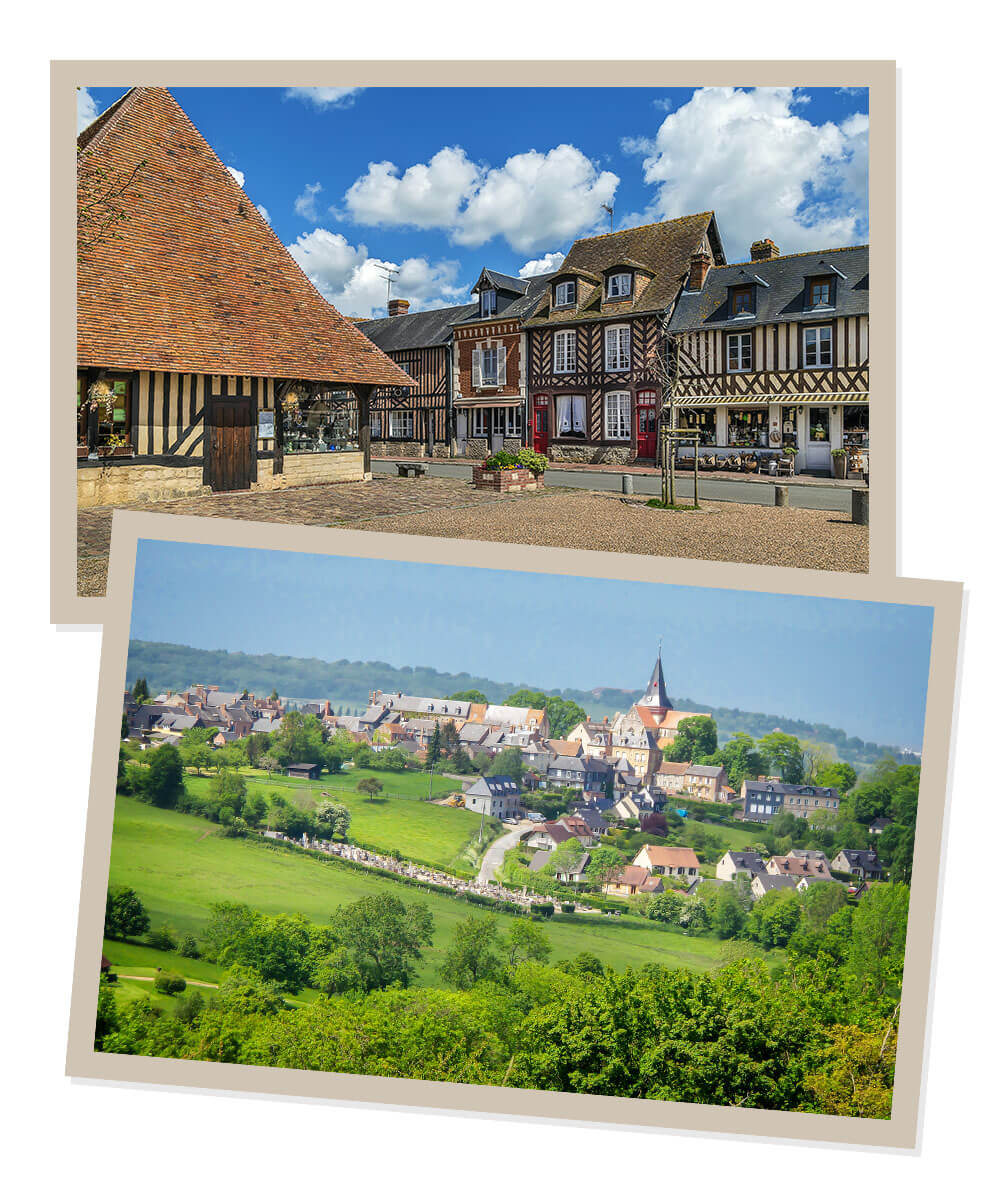 D-Day Landing beaches: The D-Day beaches are historic sites of the Allied landings on June 6, 1944, a crucial operation that led to the liberation of Western Europe from Nazi occupation. These beaches—Omaha, Utah, Gold, Juno, and Sword—are now memorialized with museums, monuments, and cemeteries, honoring the bravery and sacrifice of the soldiers who fought there.
D-Day Landing beaches: The D-Day beaches are historic sites of the Allied landings on June 6, 1944, a crucial operation that led to the liberation of Western Europe from Nazi occupation. These beaches—Omaha, Utah, Gold, Juno, and Sword—are now memorialized with museums, monuments, and cemeteries, honoring the bravery and sacrifice of the soldiers who fought there.
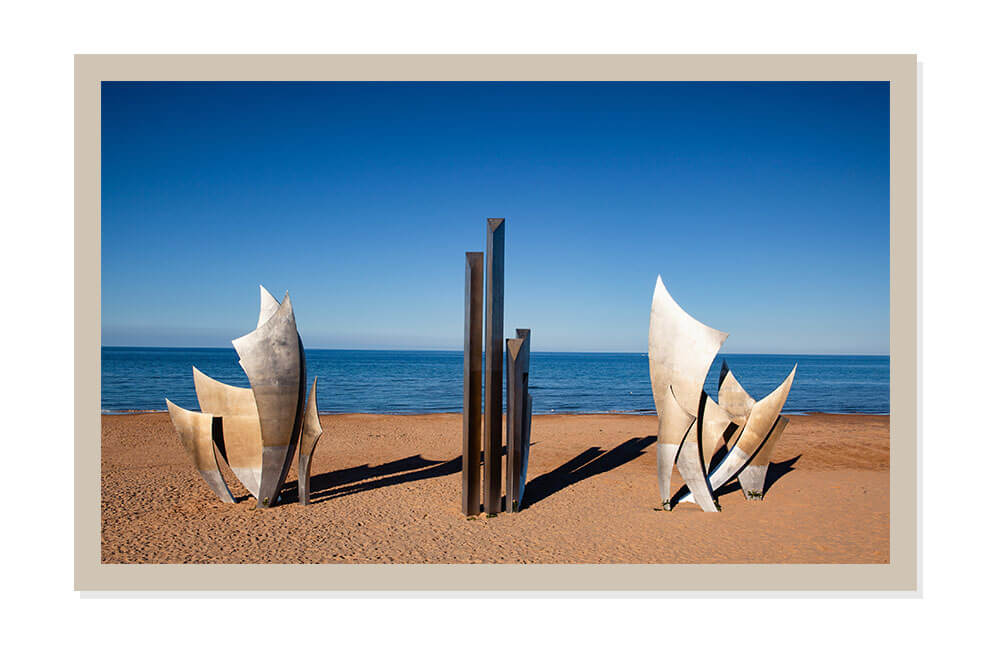
Normandy, renowned for its rich culinary tradition, boasts several specialty foods that showcase the region's diverse flavors and agricultural abundance. Some notable Normandy specialty foods include:
- MOUCLADE NORMANDE AU SAFRAN
- Camembert and Pont-l'Évêque Cheese: These creamy, soft cheeses are emblematic of Normandy's dairy heritage. Produced from cow's milk, they have a distinctive taste and texture, making them popular choices for cheese lovers worldwide.
- Calvados: This renowned apple brandy is distilled from cider made from locally grown apples. Known for its complex flavor profile and amber hue, Calvados is a staple in Normandy's gastronomy and is often enjoyed as a digestif or used in cooking.
- Normandy Cider: Made from a blend of different apple varieties, Normandy cider is crisp, refreshing, and slightly effervescent. It comes in various styles, ranging from dry to sweet, and is enjoyed both as a standalone beverage and as an accompaniment to meals.
- Teurgoule: This traditional Normandy rice pudding is made with local ingredients such as milk, rice, sugar, and cinnamon. Slow-baked to creamy perfection, teurgoule is a comforting and indulgent dessert enjoyed by locals and visitors alike.
- Boudin Noir: Normandy is known for its charcuterie, and boudin noir, or blood pudding, is a specialty often found in the region. Made with pork blood, fat, and spices, it has a rich, savory flavor and is typically served grilled or fried. Note: different from the Louisiana Cajun boudin.
- Apple Tart: With its abundance of orchards, Normandy is famous for its apple-based desserts, including the classic apple tart. Made with thinly sliced apples layered atop a buttery pastry crust and glazed with apricot jam, it's a delightful way to showcase the region's flavorful apples.
- Sucre d'orge de Rouen: A traditional barley sugar candy that reflects the region's sweet heritage.
Mouclade Normande au Safran is a tantalizing French culinary creation hailing from the picturesque region of Normandy. This exquisite dish features plump, juicy mussels bathed in a velvety sauce, rich with the flavors of saffron, shallots, garlic, and a hint of Calvados. The harmonious blend of these ingredients creates a symphony of taste sensations that dance on the palate with every bite.
To prepare Mouclade Normande au Safran, fresh mussels are first cleaned and “debearded”, ensuring only the finest quality shellfish make their way into the dish. The sauce, a key component of this indulgent delicacy, is meticulously crafted by sautéing shallots and garlic until fragrant, then adding a generous pinch of saffron threads, which impart not only a mesmerizing golden hue but also a subtle floral note.
Some variations of mouclade incorporate a touch of curry powder, adding a delightful depth of flavor and a hint of warmth to the sauce. However, the Normande version typically relies on the distinct flavors of local ingredients. Once the saffron has infused its essence into the mixture, a splash of apple cider is added, infusing the sauce with a delicate acidity that balances the richness of the cream to come.
Cream is then introduced to the pan, gradually thickening and enveloping the aromatics in its luxurious embrace. As the sauce simmers and melds, the mussels are gently nestled into the bubbling concoction, allowing them to soak up the flavors and release their briny essence into the sauce.
The dish is typically finished with a splash of Calvados and a sprinkling of fresh herbs, such as parsley, adding a pop of color and a final flourish of flavor. Mouclade Normande au Safran is often served piping hot, accompanied by crusty bread, perfect for sopping up every last drop of the sumptuous sauce.
Whether enjoyed as an elegant appetizer or a decadent main course, Mouclade Normande au Safran is sure to delight even the most discerning palate with its exquisite blend of flavors and textures, making it a beloved classic in French cuisine.
Mouclade Normande au Safran is a luxurious and flavorful dish that brings together the best of Normandy’s culinary traditions (apple cider, Calvados brandy, cream) with the delicate taste of saffron. This recipe offers a rich and aromatic experience, perfect for a special occasion or a delightful dinner as an appetizer or main dish.
around the MUSSELS
- Moules Marinières A French favorite dish, mussels cooked in a flavorful broth of white wine, shallots, and herbs
- Moules au pastis Combines the fresh, briny taste of mussels with the aromatic, anise-flavored spirit of pastis. This dish is a perfect blend of coastal simplicity and Provencal flair, offering a unique twist on the classic moules marinières.
- Steamed mussels with leeks Combines simplicity with earthy flavors
with MOUCLADE NORMANDE AU SAFRAN
- Cidre de pommes (Hard apple cider)
- Muscadet (Pays de Loire white wine)
- Sauvignon blanc (Bordeaux white wine)
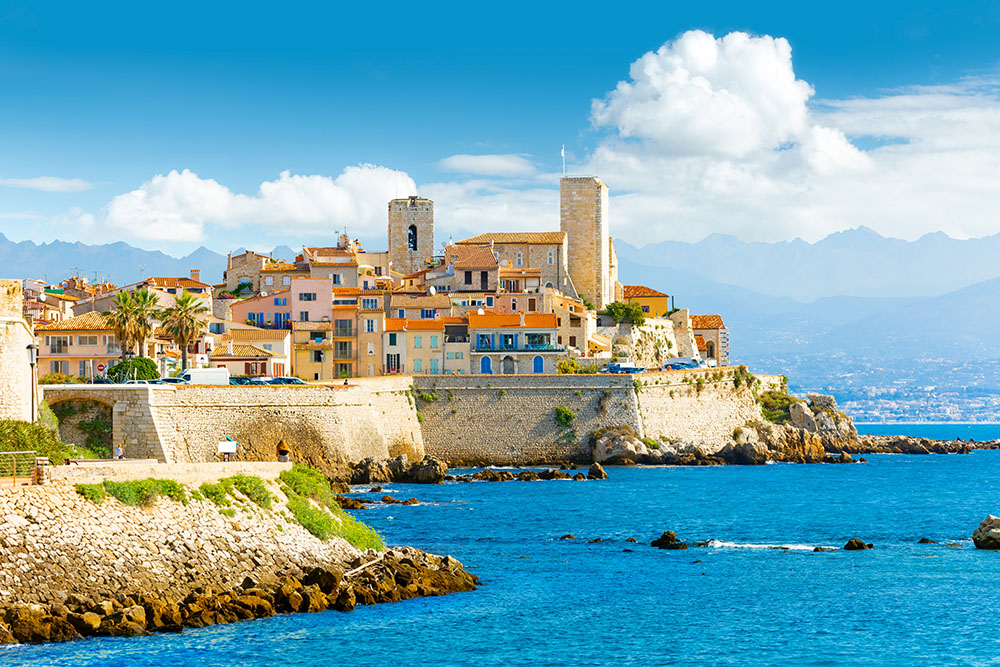
SOUTHEASTERN FRANCE
Let's go South! Our fourth stopover is Antibes, located on the French Riviera. It’s one of the eldest city founded during Antiquity era.
I chose this destination over more famous French Riviera towns as I used to go there for summer vacation as a kid.
Antibes, France
Recipe: Ratatouille Provençale
(French Riviera)
Antibes, situated on the French Riviera between Nice and Cannes, is renowned for its picturesque beauty, historical significance, and vibrant cultural scene. Founded by the Greeks over 2,500 years ago, it offers a fascinating blend of ancient history and modern elegance. The town is famous for its stunning coastline, sandy beaches, and the iconic Port Vauban, one of the largest marinas in Europe, home to luxurious yachts and sailing vessels. Antibes also boasts a rich cultural heritage, with attractions like the Musée Picasso, housed in a medieval château, showcasing works by the renowned artist who once lived in the town. Its charming old town, vibrant markets, and lively festivals make Antibes a captivating destination that combines relaxation, history, and cultural exploration along the sun-kissed shores of the Mediterranean.
“I just woke up and it’s still dark outside, so we have a few more hours of driving left. I'm so excited and wish we were there already! I finished second grade ten days ago, and now we’re going to spend three weeks in Antibes. Summer vacation is the best time of the year. My parents rented the same villa as the previous years. It’s a big pinkish house with lots of palm trees and bright flowers all around. We won’t be in the villa much. Plage de la Salis, a beautiful white sand beach, is just three blocks away from the villa, and we'll spend most of our time there: swimming, building sandcastles, playing racket ball, and making new friends!
Tomorrow will be so much fun because we’re going shopping for new swimsuits, flip-flops, and sunglasses. For the next few weeks, I’ll mostly wear swimsuits, miniskirts, and t-shirts.
Even on vacation, we have a routine. Three times a week, we will go to the Marché Provençal to buy the yummiest fruits and vegetables. My favorite are the local melons. They are so juicy and sweet. I love wandering through the stalls. The vendors talk with a unique Provençal singing accent.
During these three weeks, our meals will mostly be cold with lots of local fruits and vegetables. One of my favorites is Pan Bagnat - a round bread filled with lettuce, tuna, hard-boiled egg, tomato, black olive, and olive oil. I could eat one every day.
We will also hike a few times in the hills above the city. The footpaths have funny names, and we feel like adventurers: Chemin des Douaniers (Customs Officers' Path) and Chemin des Contrebandiers (Smugglers' Path). Like every year, we will go to St. Tropez once, where we will have a lemonade and a slice of tarte Tropézienne at the famous Sénéquier café while watching the yachts in the port. We will also go to Monaco once to watch the Changing of the Guard in front of the Palace and visit the botanical garden.
Another exciting day will be July 14th (Bastille Day). We will watch the fireworks over the old town from the beach, where people will sing and dance.”
These are childhood memories, so they may not be completely accurate. I later realized that the villa was actually white, with enormous fuchsia bougainvillea that gave it a pinkish hue. It was a family house that had been converted into five rental apartments. The beauty of childhood memories is that you remember the best parts. For me, it was the perfect place to spend our summer vacations.
The French Riviera, or Côte d'Azur, is a legendary stretch of coastline that spans from Saint-Tropez to Menton, offering a tapestry of sun-soaked beaches, crystal-clear waters, and picturesque towns. Renowned for its luxurious resorts, historic sites like Nice's Promenade des Anglais, Cannes' Palais des Festivals, and Monaco's Monte Carlo Casino add cultural richness. Its blend of Mediterranean allure, fine dining, and vibrant nightlife has made it a magnet for artists, celebrities, and travelers seeking both relaxation and sophistication along the shimmering Mediterranean.
Nice: Nice, the largest city on the French Riviera, captivates visitors with its blend of Mediterranean charm, rich history, and vibrant cultural scene. From the iconic Promenade des Anglais along its stunning coastline to the lively markets and atmospheric Old Town (Vieux Nice) with its narrow streets and colorful buildings, Nice offers a delightful mix of relaxation and exploration. Its museums, including the Musée Matisse and Musée Marc Chagall, showcase impressive collections, while its cuisine, featuring local specialties like socca (chickpea pancake) and salade niçoise, celebrates the flavors of Provence in a picturesque coastal setting.
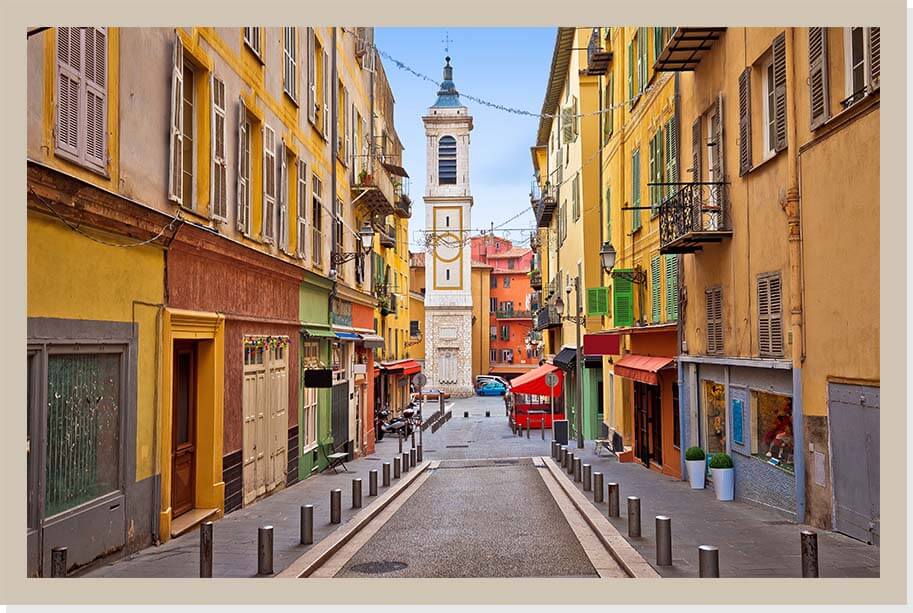
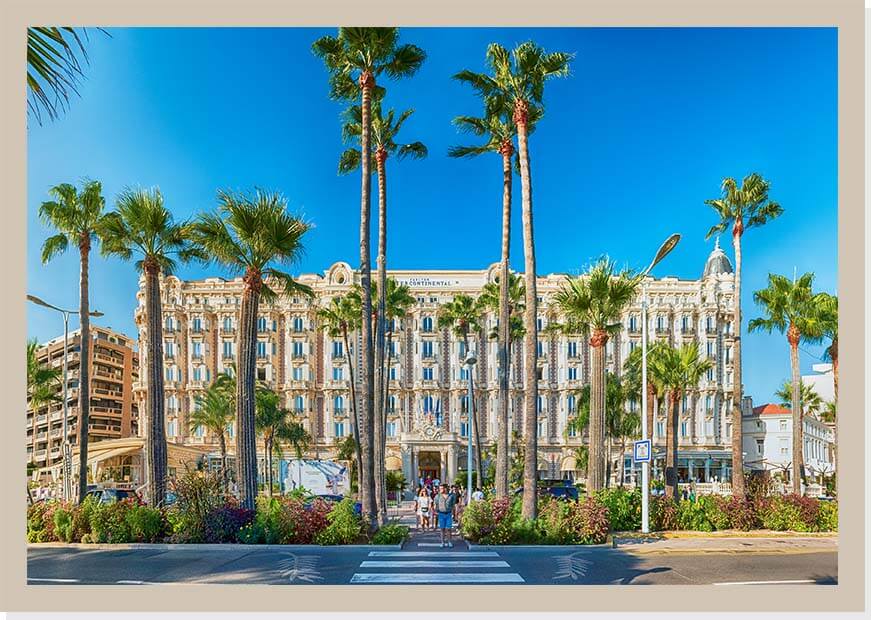
St Tropez: Saint-Tropez, a picturesque town on the French Riviera, gained global fame in the 1950s thanks to cultural icons like Brigitte Bardot, who helped transform it from a quaint fishing village into a glamorous destination. Renowned for its stunning beaches, vibrant nightlife, and upscale boutiques along cobblestone streets, Saint-Tropez remains a magnet for celebrities and travelers seeking Mediterranean charm and luxury. Its harbor, filled with opulent yachts, and the historic allure of its old town blend seamlessly with Provençal culture, offering visitors a taste of both relaxation and sophistication in an idyllic coastal setting.
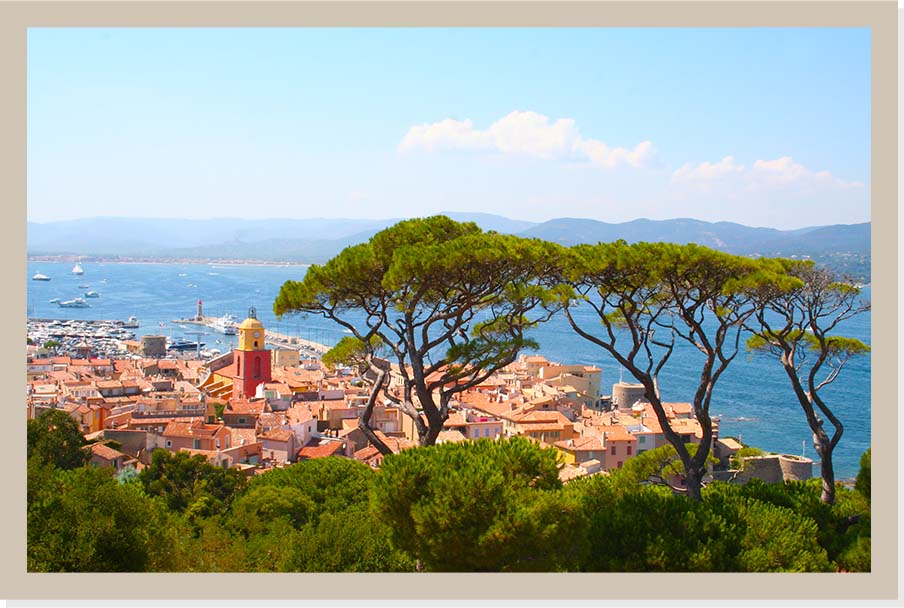
Grasse: Grasse, nestled inland from the French Riviera, is celebrated as the perfume capital of the world, renowned for its centuries-old tradition of fragrance production. Surrounded by fields of jasmine, lavender, and roses, Grasse's perfumeries offer immersive tours where visitors can discover the art of perfume-making. Beyond its olfactory heritage, Grasse enchants with its medieval old town, charming squares, and panoramic views over the Provence countryside. This historic town blends cultural richness with natural beauty, making it a captivating stop for those exploring the French Riviera's hinterland.
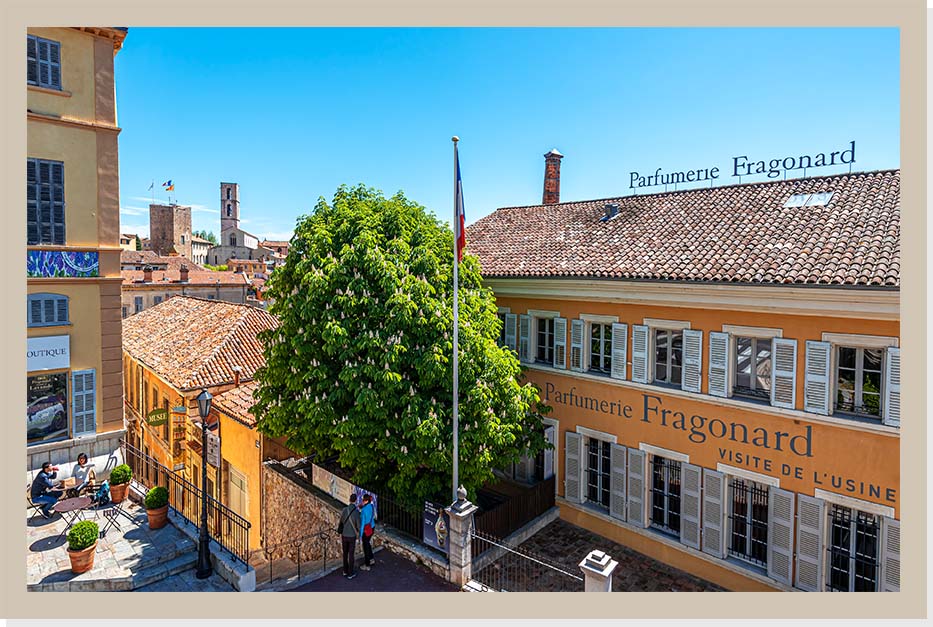
Monaco: Monaco, a tiny principality on the French Riviera, exudes glamour, wealth, and history in equal measure. Famous for its upscale casinos, including the iconic Monte Carlo Casino, Monaco attracts visitors with its luxury yachts, Formula 1 Grand Prix race, and the opulent Prince's Palace overlooking the Mediterranean. Despite its small size, Monaco offers cultural treasures such as the Oceanographic Museum and the picturesque old town of Monaco-Ville, making it a fascinating blend of Mediterranean beauty and exclusive sophistication.
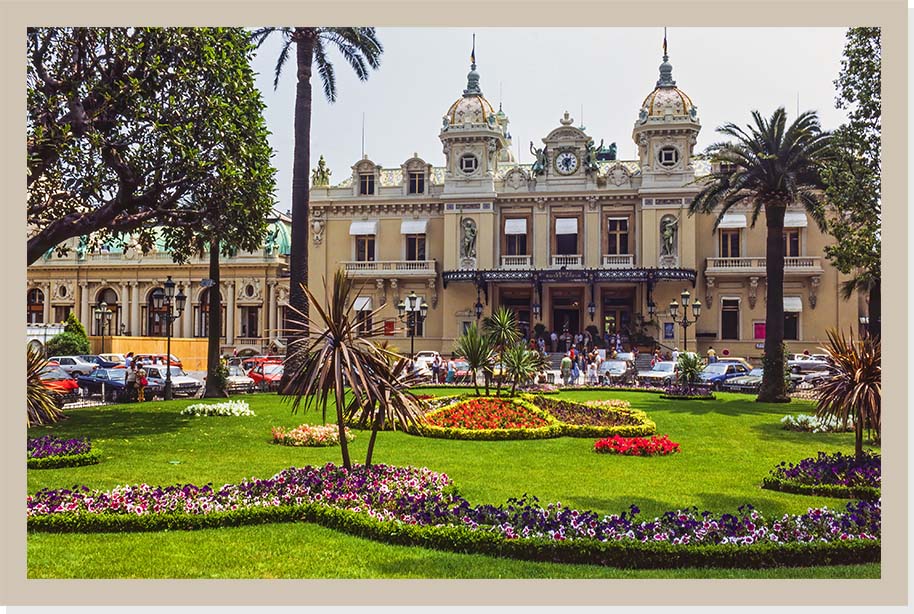
Provence, known for its rich culinary heritage, boasts several famous food specialties that highlight the region's fresh produce, aromatic herbs, and Mediterranean flavors:
- RATATOUILLE
- Pan Bagnat: Pan Bagnat, a specialty from Nice, French Riviera, is a sandwich that combines ingredients typical of a Niçoise salad, such as tuna, hard-boiled eggs, olives, and fresh vegetables, all soaked in olive oil. The crusty bread absorbs the flavors, creating a deliciously moist and flavorful meal. This sandwich is perfect for picnics or a hearty lunch, embodying the essence of Provençal cuisine.
- Fougasse: Fougasse is a traditional French bread from Provence, often shaped like a leaf or an ear of wheat. It is typically flavored with ingredients such as olives, herbs, garlic, or anchovies, giving it a distinctive taste and aroma. This decorative and flavorful bread is perfect as a snack, appetizer, or accompaniment to meals.
- Pissaladière: Pissaladière is a savory tart from the Provence region of France, similar to a pizza but without cheese. It features a thick, bread-like crust topped with caramelized onions, olives, and anchovies, creating a rich and flavorful dish. Traditionally enjoyed as an appetizer or snack, pissaladière showcases the robust flavors of Provençal cuisine.
- Daube Niçoise: Daube Niçoise is a traditional Provençal stew from Nice, made with beef braised slowly in red wine, vegetables, garlic, and aromatic herbs like thyme and bay leaves. Often enriched with black olives and sometimes a hint of orange zest, this hearty dish is typically served with pasta, polenta, or potatoes. Its rich, deep flavors develop over long, slow cooking, making it a comforting and flavorful meal.
- Soupe au pistou: Soupe au Pistou is a classic Provençal vegetable soup from southern France, brimming with summer vegetables like tomatoes, green beans, and zucchini, as well as white beans and pasta. The highlight of the soup is the pistou, a fragrant basil sauce similar to pesto but without nuts, stirred in just before serving. This hearty and aromatic soup is a celebration of fresh, seasonal produce and Mediterranean flavors.
- Beignets de fleur de courgette: Beignets de fleur de courgette, or zucchini flower fritters, are a delicate and delicious specialty from Provence. Fresh zucchini blossoms are dipped in a light, airy batter and fried until crispy and golden. These savory fritters are often enjoyed as an appetizer or snack, showcasing the subtle flavor of the blossoms.
- Salade Niçoise: A salad originating from Nice, typically featuring tomatoes, hard-boiled eggs, olives, anchovies, and either tuna or anchovies, all arranged on a bed of lettuce with a vinaigrette dressing.
- Tapenade: Tapenade is a spread made from olives, capers, anchovies, olive oil, and sometimes herbs or garlic, used as a condiment or dip.
- Tarte Tropézienne Tarte Tropézienne is a delightful French dessert originating from Saint-Tropez. It consists of a round brioche bun split in half and filled with a rich, creamy mixture of pastry cream and buttercream. Lightly dusted with pearl sugar, this indulgent treat is beloved for its soft texture and luscious filling.
Ratatouille is a beloved Provencal dish that captures the essence of Mediterranean cooking with its vibrant colors and rich flavors. It begins by gently sautéing onions, garlic, and aromatic herbs like thyme and bay leaf in olive oil until fragrant. Then, layers of tomatoes, zucchini, eggplant, and bell peppers are added, each carefully sliced to showcase their individual textures and flavors. As the stew simmers, the vegetables release their juices, melding together into a harmonious medley that is both hearty and comforting.
Traditionally, ratatouille is cooked slowly over low heat, allowing the flavors to deepen and intensify. This method not only tenderizes the vegetables but also enhances their natural sweetness. Some variations include adding a splash of white wine or a spoonful of tomato paste for extra depth.
Once cooked, ratatouille can be enjoyed in various ways: served hot as a side dish alongside roasted meats or grilled fish, chilled as a refreshing appetizer, or even as a topping for pasta, rice, or crusty bread. Its versatility makes it a staple in Mediterranean cuisine, cherished for its ability to showcase the freshest seasonal produce in a simple yet incredibly flavorful manner. Whether enjoyed in a rustic farmhouse kitchen or at a bustling Provencal market, ratatouille embodies the spirit of Provence – wholesome, robust, and deeply satisfying.
Ratatouille is a traditional Provençal vegetable stew made with a mix of eggplant, zucchini, bell peppers, tomatoes, onions, and herbs, typically simmered until tender and flavorful.
What to do with RATATOUILLE leftovers
- Ratatouille pasta Add ratatouille to your favorite pasta.
- Ratatouille quiche Drain your ratatouille to remove as much liquid as possible and use it as a quiche filling. Just add 3 beaten eggs and 1 cup of heavy cream. Pour the mixture onto pastry dough and bake for 30 minutes in a preheated oven at 375°F (190°C).
- Ratatouille salad Mix ratatouille with cooked and cooled quinoa. Add 1 tsp of olive oil.
- Ratatouille soup Blend 1 cup of ratatouille with 1/3 cup of vegetable broth to make a soup.
with RATATOUILLE
- Rosé de Provence
- Côte de Provence blanc (Provençal white wine)
- Côte du Rhône (red wine)
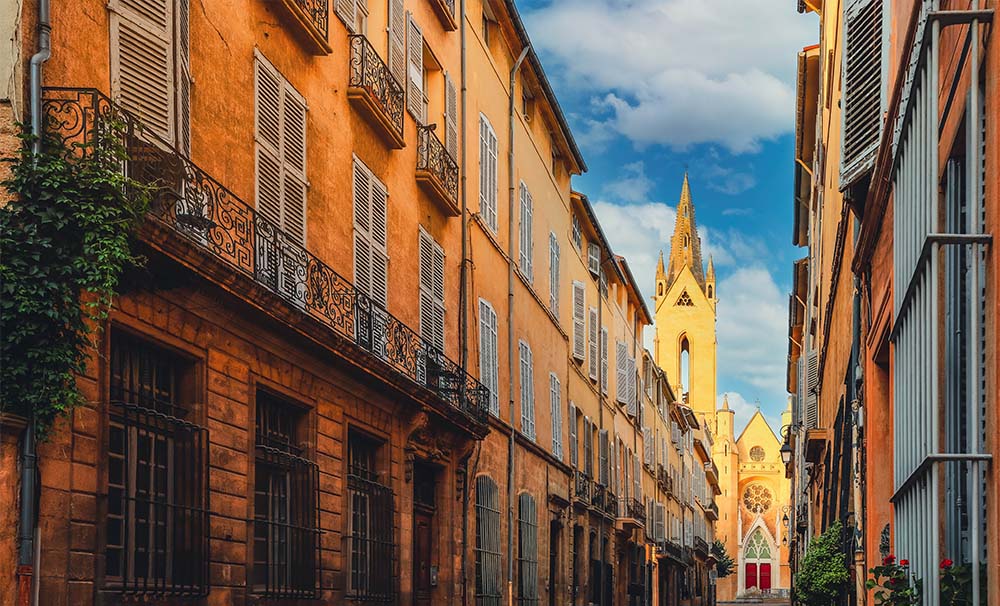
SOUTHEASTERN FRANCE
Our fifth stopover is Aix-en-Provence which is the quintessence of Provence. It was frequented by Paul Cézanne, Émile Zola and Ernest Hemingway to name a few.
I chose this destination for the “provençal” vibes I love.
Aix-en-Provence, France
Recipe: Rosemary shortbread cookies
Aix-en-Provence, often simply called Aix, is a charming city in the south of France known for its vibrant art, culture, and history. Founded by the Romans, it features well-preserved architecture, including the iconic Cours Mirabeau, a tree-lined avenue with elegant fountains and cafes. The city is famous for being the birthplace of Paul Cézanne, and his influence is celebrated through numerous museums and art galleries. Aix is also home to one of the oldest universities in France, giving it a lively, youthful vibe amidst its historic beauty. The local markets offer a taste of Provençal life with fresh produce, cheeses, and regional specialties.
My typical day in Aix-en-Provence would kick off with a morning ritual of coffee and a freshly baked croissant at a café on Cours Mirabeau. I'd take my time, soaking in the morning sun and the lively chatter around me, planning out my day.
After breakfast, I'd make my way to Cézanne's Studio, always feeling a spark of creativity there, imagining the great artist at work. From there, I'd explore the winding, cobblestoned streets of the old town, stopping at small boutiques for local crafts, perhaps picking up some lavender soap or a piece of Provençal fabric.
Lunchtime would lead me to the Marché de Provence, where I'd indulge in a feast of local flavors - fresh goat cheese, tapenade, and a glass of the region's renowned rosé wine, enjoying the market's bustling energy and the camaraderie of fellow food lovers.
In the afternoon, before heading to the Quartier Mazarin to admire the elegant 17th-century mansions, I'd pause at Cours Mirabeau to watch the elder men playing pétanque. The sight of them, with their focus and camaraderie, tossing the boules with precision, would always bring a smile to my face. It's a quintessential Aix moment, where time seems to slow down amidst the clinking of metal balls and the strategic discussions.
If I felt like some culture, I'd spend time at Musée Granet, losing myself in art. If it was Thursday, the flower market at Place de l'Hôtel de Ville would be a must-visit, its colors and scents a feast for the senses.
Later, as the heat of the day subsided, I'd find solace in the gardens of Pavillon de Vendôme, reading or simply enjoying the tranquility. Or, if I felt adventurous, I'd drive up to Sainte-Victoire Mountain, inspired by Cézanne's landscapes, to catch the sunset or enjoy a short hike.
Dinner would be at a cozy bistro, where I'd savor dishes like bouillabaisse or ratatouille, washed down with a local wine. The evening would then unfold with a walk through Aix, the city coming alive under night lights, perhaps grabbing a scoop of gelato from a favorite spot.
To cap off the night, I'd find a café for a nightcap, sometimes listening to live music or just enjoying the company of new friends or the solitude of my thoughts. This ritual of ending the day in Aix, with its blend of history, culture, and the simple pleasures of life, is what makes it feel like home.
Provence, capturing the soul of France through cities like Aix-en-Provence, Arles, and Avignon, is a land where history, art, and nature blend seamlessly. The region is celebrated for its Roman ruins, the artistic legacy of luminaries like Van Gogh, and the untamed beauty of the Camargue, but it's the iconic lavender fields that truly embody its spirit. These fields, stretching across the countryside in a sea of purple, alongside the region's Provençal cuisine, vibrant markets, and timeless villages, make Provence a place where one can experience the heart of French culture and nature.
Marseille: Marseille, established by Greek settlers around 600 BC, stands as France's oldest city and a significant Mediterranean port. It's renowned for its diverse cultural tapestry, where European, African, and Middle Eastern influences blend seamlessly. The city is famous for bouillabaisse, a hearty fish stew, but its culinary landscape is much broader, encompassing everything from North African dishes to local pastries.
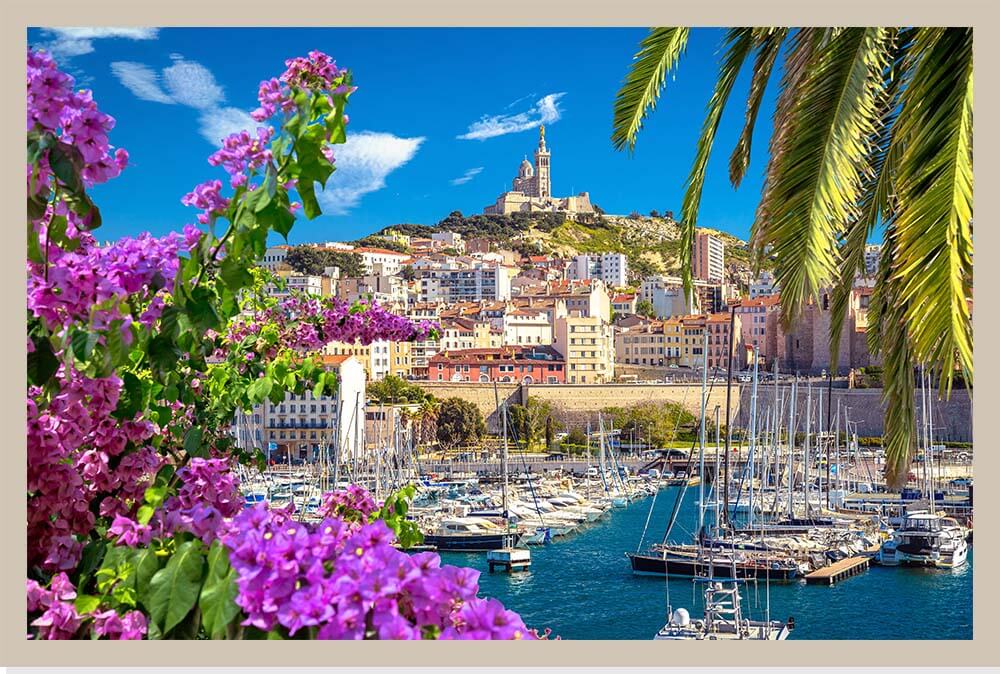
Historically rich, Marseille's landmarks like the Basilica of Notre-Dame de la Garde offer spectacular views, while the bustling Old Port (Vieux-Port) serves as the city's vibrant heart. Modern Marseille is a city of contrasts, with areas undergoing urban renewal and others showcasing the raw edges of life in a port city.
Culturally, Marseille is alive with street art, particularly in the old district of Le Panier, and it's a football city, passionate about Olympique de Marseille. The city hosts various festivals, contributing to its lively atmosphere. However, Marseille also faces challenges, including social integration, crime, and urban decay in some neighborhoods, reflecting a city that's both beautiful and complex, embodying the spirit of the Mediterranean.
Frioul Archipelago: The Frioul archipelago, located off the coast of Marseille in the Mediterranean, comprises four islands: Pomègues, Ratonneau, If, and Tiboulen. Known for their rugged beauty and clear waters, these islands are part of the Calanques National Park, offering stunning landscapes with limestone cliffs, secluded coves, and sandy beaches. The Château d'If, famous from Alexandre Dumas' "The Count of Monte Cristo," sits on If Island, drawing history and literature enthusiasts. The islands serve as a natural escape from the city, ideal for hiking, swimming, and enjoying marine life, while also providing a glimpse into Marseille's maritime and military past with old fortifications and quarantine stations. They represent a piece of untouched nature close to urban life, where biodiversity thrives, and visitors can disconnect from the hustle of the mainland.
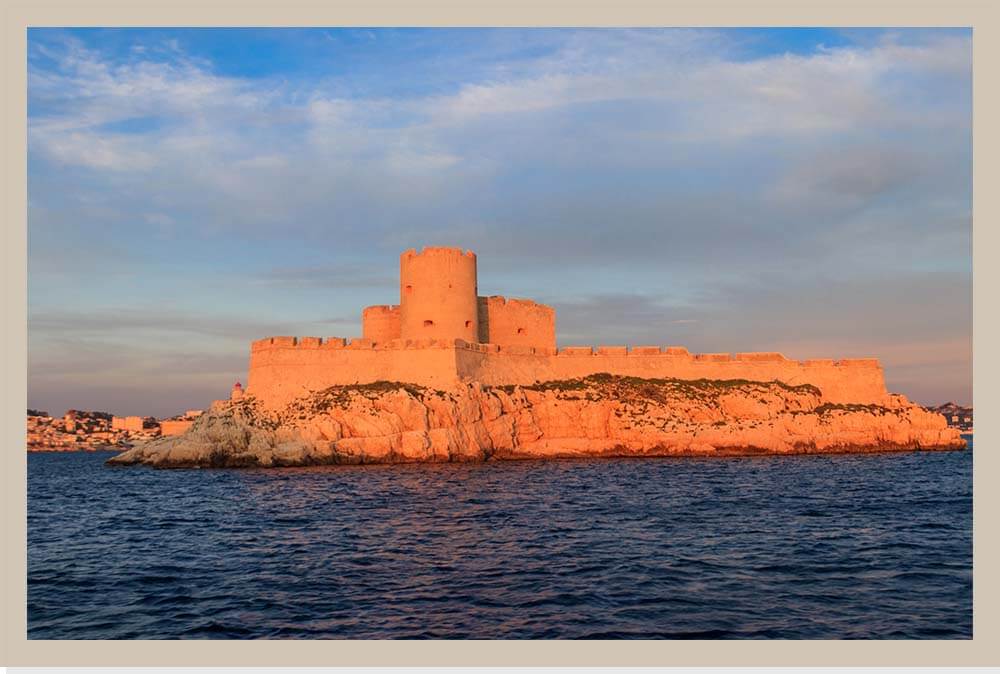
Avignon: Avignon, nestled in the heart of Provence, is most famous for the Palais des Papes, a symbol of the city's historical significance as the seat of Western Christianity during the 14th century. Encircled by medieval walls, Avignon exudes a charm that blends history with modern life. The city hosts the renowned Avignon Festival, turning its streets into stages for theatre, dance, and art each summer. The iconic Pont d'Avignon, or Pont Saint-Bénézet, adds to its picturesque setting by the Rhône River. Like Marseille, Avignon boasts a rich culinary scene, with local specialties like tian and truffles. However, unlike the bustling port city, Avignon offers a more serene, artistic vibe, with its narrow, cobblestoned streets, small art galleries, and the peaceful Place de l'Horloge. It's a city where history isn't just remembered but lived, making it a captivating destination in the south of France.
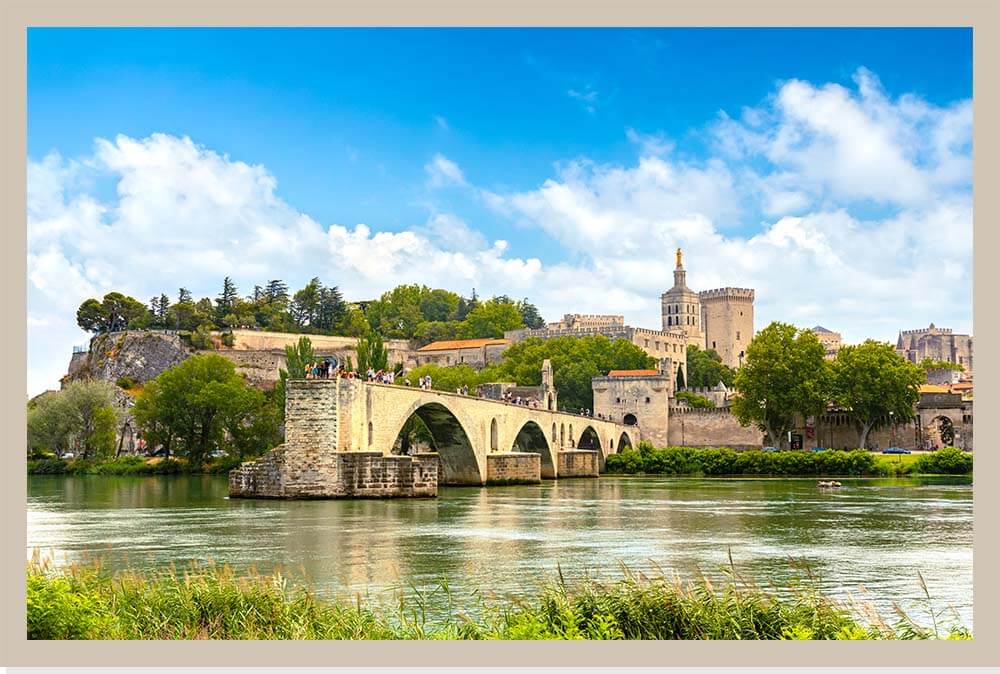
Arles: Arles, in the heart of Provence, is celebrated for its Roman heritage and as a muse for Vincent van Gogh, who painted some of his most famous works here. The city's well-preserved Roman amphitheater and theater add to its ancient allure, while the vibrant yellow of Van Gogh's sunflowers seems to color the landscape. Arles hosts the Rencontres d'Arles, an international photography festival, bringing contemporary art to its historic streets. The Rhône River flows by, offering serene views and a connection to nature. Like Avignon, Arles combines the old with the new, where medieval architecture meets modern art installations, making it a cultural gem in Southern France. However, it's less about the hustle of a major city and more about the quiet beauty and the light that inspired so many artists.
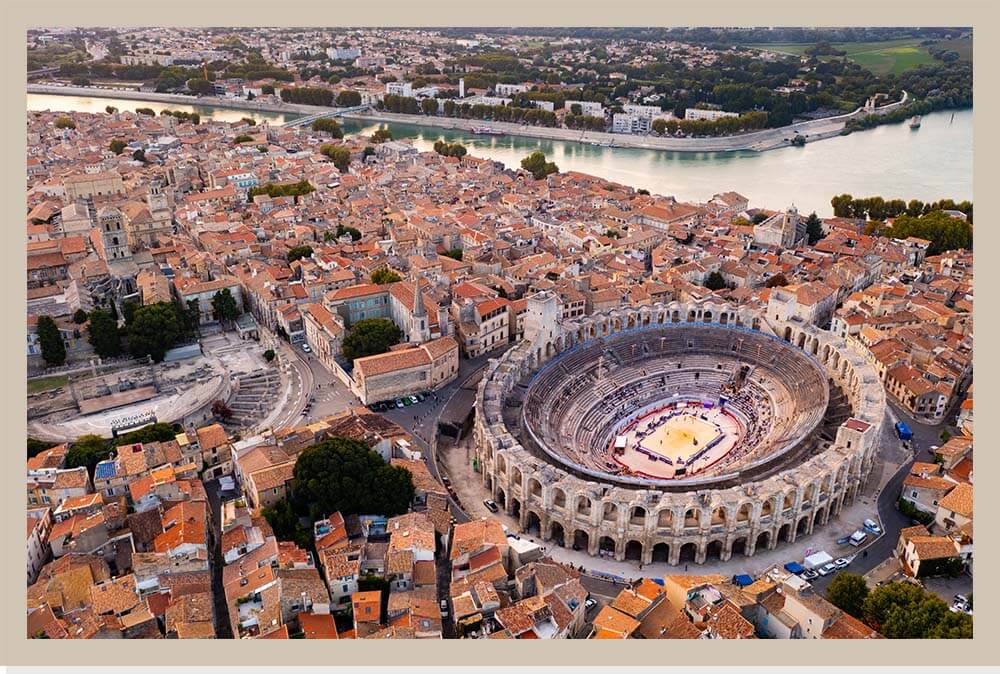
Nîmes: Nîmes, located in the heart of the Gard department of France, is renowned for its remarkable Roman heritage, most notably the well-preserved Amphitheatre (Les Arènes), which still hosts bullfights and concerts. Another significant site is the Maison Carrée, one of the best-preserved temples from the Roman Empire, offering insight into ancient Roman architecture. Beyond its historical treasures, Nîmes combines a vibrant modern life with its past, featuring contemporary art spaces, a lively market culture at the Les Halles de Nîmes, and the innovative Nîmes Museum. The city also boasts the Jardins de la Fontaine, an 18th-century garden built around the Roman Temple of Diana, blending nature with history. Nîmes encapsulates the spirit of both ancient and modern France, making it a compelling destination for those interested in history, culture, and the Mediterranean lifestyle.
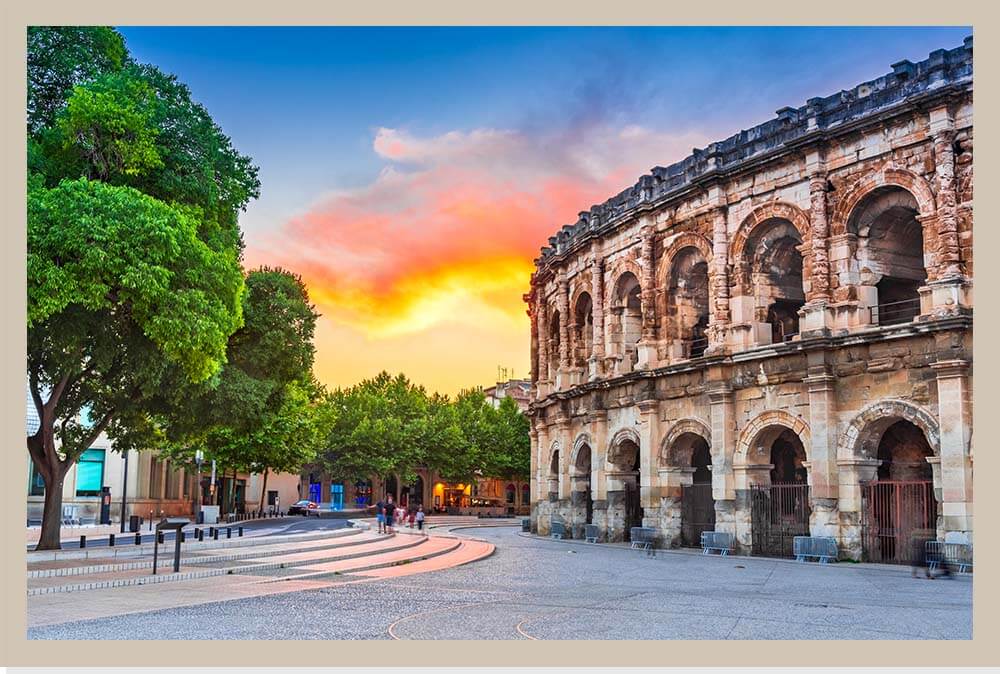
Pont du Gard: The Pont du Gard, an ancient Roman aqueduct near Nîmes in Provence, is a marvel of engineering and architecture. Constructed in the 1st century AD, this three-tiered bridge stands at 48.8 meters tall, originally part of an aqueduct system that carried water over 50 kilometers to the Roman colony of Nemausus (Nîmes). Recognized as a UNESCO World Heritage site since 1985, it's not only a testament to Roman ingenuity but also a scenic attraction, where visitors can walk across its arches, appreciate the surrounding natural beauty, and explore the museum dedicated to its history and construction. The Pont du Gard symbolizes the height of Roman technical prowess and remains one of the best-preserved Roman structures in the world.
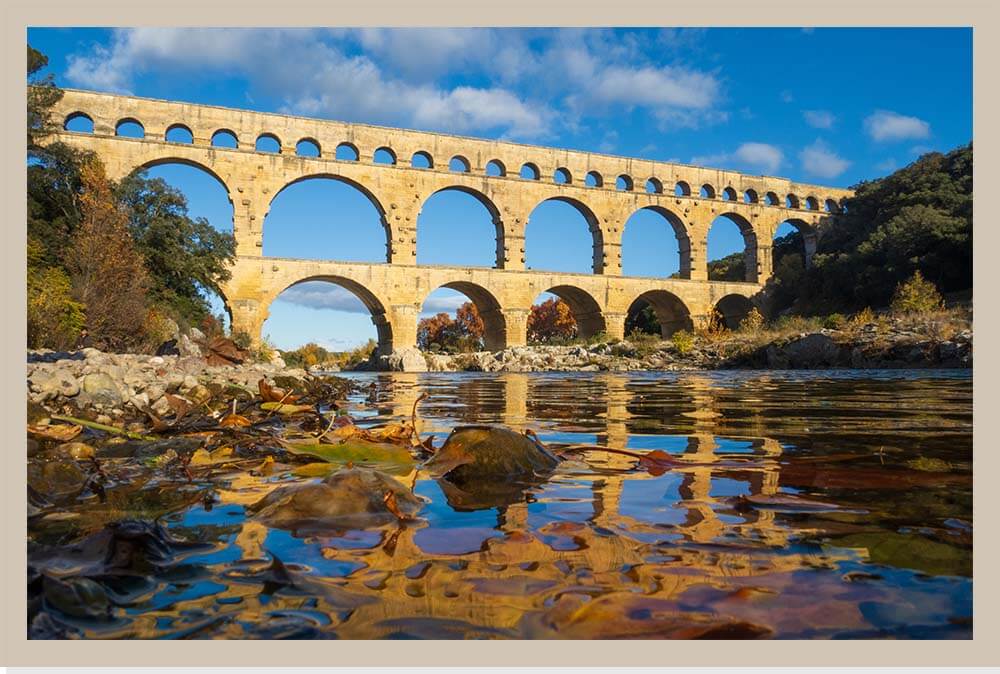
Camargue: The Camargue, located at the delta of the Rhône River in southern France, is a unique natural region known for its wild landscapes, white horses, black bulls, and pink flamingos. This vast wetland and marsh area contrasts sharply with the more urban environments nearby, offering expansive salt flats, rice fields, and lagoons. It's a haven for birdwatchers and nature lovers, with the Camargue Regional Nature Park protecting its biodiversity. The region also has a distinctive cultural identity, with the gardians (cowboys) herding cattle and the traditional music and dance of the area. Unlike the historical cities of Provence, Camargue is about experiencing nature's untamed beauty, where the Mediterranean meets the wild, creating an enchanting, if sometimes harsh, environment.
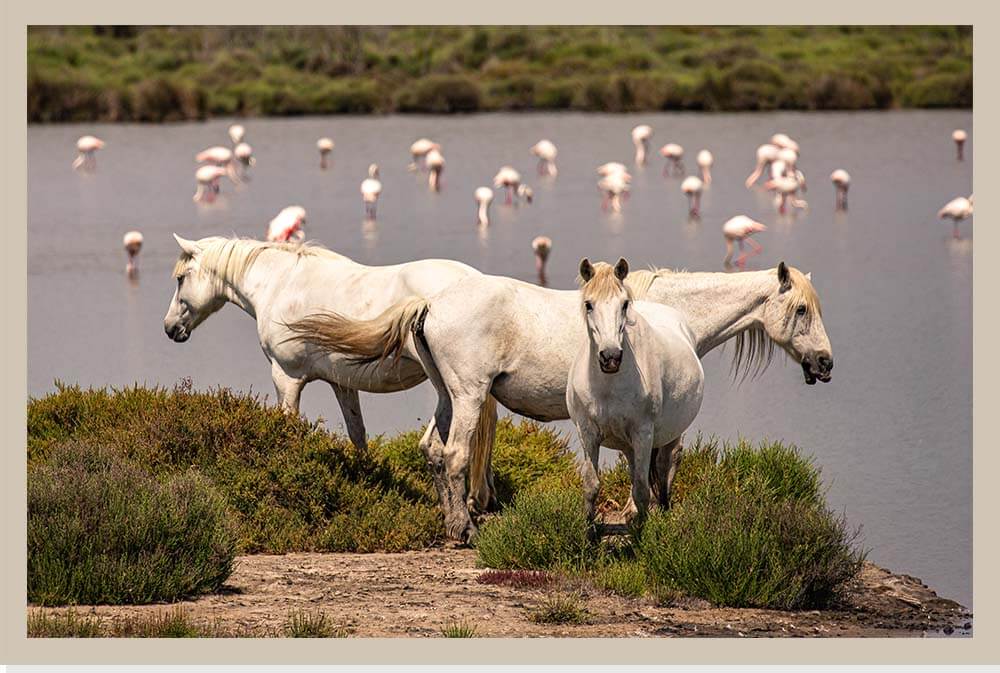
Provence, known for its rich culinary heritage, boasts several famous food specialties that highlight the region's fresh produce, aromatic herbs, and Mediterranean flavors:
- SABLÉS PROVENÇAUX
- Bouillabaisse: Bouillabaisse is more than just a dish; it's a culinary emblem of Marseille, reflecting the city's rich fishing heritage. This hearty fish stew, traditionally made from the catch of the day, combines various Mediterranean fish with an aromatic broth flavored by saffron, garlic, and fennel among other herbs. Typically enjoyed with rouille, a spicy garlic sauce, and croutons, bouillabaisse is not just food but an experience, best savored in one of Marseille's waterfront restaurants where the sea's bounty is celebrated.
- Pompe à huile: La pompe à l'huile is a traditional Provençal flatbread that's a staple during Christmas celebrations, particularly on the table of the "Gros Souper" before midnight mass. This sweet brioche-like bread is made with olive oil, giving it its name, and flavored with orange blossom water, aniseed, and sometimes candied fruits. Its unique texture and flavor capture the essence of Provence's culinary heritage, offering a delightful contrast to the region's more savory dishes.
- Calisson d’Aix: Calissons d'Aix are almond-shaped confections from Aix-en-Provence, embodying the essence of Provençal sweets. Made from a paste of finely ground almonds, candied melon, and orange peel, these delicacies are topped with a thin layer of royal icing and sit on a rice paper base. Recognized for their distinctive diamond shape, calissons have been a cherished treat since the 17th century, often enjoyed as a symbol of the region's rich gastronomic tradition, particularly during festive occasions.
- Nougat de Montélimar: Nougat de Montélimar is a renowned French confection from the town of Montélimar in the Drôme region of Provence. This sweet treat is celebrated for its unique blend of honey, sugar, egg whites, and a generous amount of almonds and pistachios, which give it a distinctive texture and flavor. Known since the 18th century, Montélimar nougat comes in both white (soft) and brown (harder) varieties, often wrapped in edible rice paper. It's a quintessential part of French Christmas traditions, symbolizing the festive spirit with its rich, nutty taste and chewy consistency.
- Tian: Tian is a traditional Provençal dish that embodies the essence of Mediterranean cooking with its focus on fresh, seasonal vegetables. Often likened to a gratin, tian is a casserole where thinly sliced vegetables like tomatoes, zucchini, eggplant, and sometimes potatoes or onions are arranged in layers or concentric circles in a baking dish. These vegetables are seasoned simply, perhaps with just salt, pepper, and herbs like thyme or basil, before being baked slowly, allowing their flavors to meld together. The result is a dish that's both visually appealing with its mosaic of colors and flavors, and comforting in its rustic simplicity. While the basic recipe is quite straightforward, regional variations might include different vegetables or additional herbs, showcasing the diversity within Provençal cuisine.
- Aïoli: Aïoli is a quintessential Provençal sauce, emblematic of the region's love for garlic and olive oil. At its core, aïoli is an emulsion made from garlic mashed into a paste and then vigorously whisked or pounded with olive oil until it thickens into a creamy, pungent sauce. The name itself - derived from Provençal "ai" (garlic) and "oli" (oil) - tells the story of its primary ingredients.
- Anchoïade: Anchoïade is a bold Provençal sauce made from anchovies, garlic, and olive oil, often with vinegar or lemon juice. This pungent dip or spread pairs well with vegetables, bread, or grilled foods, embodying the Mediterranean's flair for simple, flavorful cuisine.
- Pastis: Pastis is a traditional French aperitif, popular in the Provence region, known for its anise flavor and refreshing quality. Typically mixed with water, it turns a milky white and is enjoyed chilled, often over ice. With brands like Ricard and Pernod leading its legacy, pastis is a symbol of southern France's laid-back lifestyle, evoking sunny afternoons and games of pétanque.
- Rosé de Provence: Rosé de Provence is a renowned type of rosé wine produced in the Provence region of southern France, celebrated for its pale pink hue and light, refreshing taste. Made primarily from grape varieties like Grenache, Cinsault, Syrah, and Mourvèdre, it often features notes of citrus, red berries, and herbs. Known as the quintessential summer wine, it pairs beautifully with Mediterranean dishes and evokes the relaxed, sun-soaked lifestyle of the Provence.
- Huile d’olive provençale: Provençale olive oil is a premium olive oil produced in the Provence region of southern France, celebrated for its exceptional quality and distinctive flavor profile. Made from traditional olive varieties like Aglandau, Bouteillan, and Cayon, it often exhibits a fruity aroma with notes of fresh grass, almonds, and a hint of peppery spice. This olive oil is a cornerstone of Provençal cuisine, enhancing dishes like ratatouille, tapenade, and salads, and embodying the region's culinary heritage and Mediterranean essence.
- Saffron: Saffron from Provence, often referred to as "red gold," is a prized spice cultivated in small quantities in the region, known for its intense aroma, deep color, and rich flavor. Harvested by hand from the delicate crocus flower, Provençal saffron is a testament to the region's dedication to artisanal farming. Its distinct taste enhances traditional dishes like bouillabaisse, risotto, and desserts, making it a cherished ingredient in Provençal and Mediterranean cuisine.
- Sel de Camargue: Camargue salt is a unique, pink sea salt harvested from the wetlands of the Camargue region in southern France. Known for its delicate flavor and high mineral content, it is traditionally collected by hand in salt ponds through natural evaporation. With its flaky texture, Camargue salt is perfect as a finishing salt for dishes like salads, meats, and desserts, adding both flavor and a colorful touch.
and lastly...
The Provençal 13 Desserts is a traditional Christmas dessert selection in Provence, symbolizing the 13 people who dined at the Last Supper. Each dessert represents different elements of the region's culture, offering a mix of sweet and savory treats made from local ingredients. Here's a look at the typical 13 desserts:
- Les Calissons: A traditional candy made from ground almonds, candied melon, and orange peel, covered with a thin layer of royal icing.
- Fruits Secs (Dried Fruits): A mix of dried figs, dates, prunes, raisins, and apricots. These fruits symbolize the abundance of the harvest.
- Nougat Blanc: A white nougat made from almonds, honey, sugar, and egg whites, symbolizing purity and happiness.
- Nougat Noir: A dark nougat made with caramelized sugar, almonds, and hazelnuts, representing strength.
- Pommes (Apples): Often spiced with cinnamon and sometimes baked, apples represent health and vitality.
- Poires (Pears): Similar to apples, pears may be poached or served fresh, representing sweetness.
- Chocolat: A variety of chocolate treats, which represent the sweetness and the luxury of the holiday season.
- Biscuits (Cookies): Typically, traditional regional cookies like *sablés* or *pain d’amande* (almond cake) are included, representing good fortune.
- Pain d’Épices: A spiced gingerbread cake, often flavored with honey, cloves, and cinnamon, symbolizing the warmth of the holiday season.
- Pompe à huile: A traditional Provençal bread made with olive oil, often flavored with orange blossom water, representing the sweetness of life.
- Cassis (Blackcurrant): A liqueur or jam made from blackcurrants, often paired with a dessert or used as a flavoring.
- Mandarines (Mandarins): Fresh mandarins, which represent the sweetness and joy of the holiday season.
- Le Raisin (Grapes): Fresh grapes, which symbolize prosperity and the abundance of the harvest.
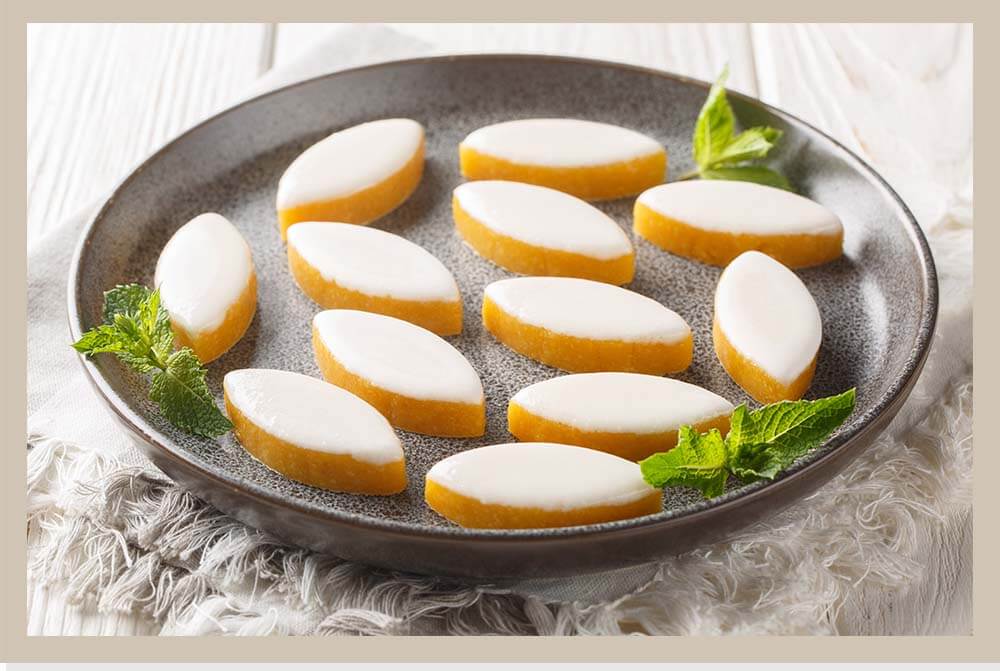
Provençal sablés are a delightful and flavorful adaptation of the classic French sablé, a cookie whose origins trace back to the Normandy region in the 17th century. The traditional sablé, named after the French word for "sandy," is known for its crumbly, melt-in-your-mouth texture, achieved by using a high ratio of butter to flour. These cookies are typically simple, made with butter, sugar, and flour, and sometimes enhanced with egg yolks, vanilla, or citrus zest for a subtle variation. Over time, the versatility of sablés led to numerous regional adaptations across France, each reflecting the local ingredients and culinary traditions of their area.
In Provence, a region celebrated for its Mediterranean cuisine, the classic sablé has been reimagined to incorporate the bold and aromatic flavors characteristic of the south of France. Provençal sablés often feature herbs like rosemary, thyme, and lavender, as well as local staples such as olive oil or Parmesan cheese. This savory twist reflects the Mediterranean diet, where fresh herbs, quality cheeses, and olives are integral to everyday cooking. Unlike their sweeter counterparts, Provençal sablés lean toward a more sophisticated, savory profile, making them ideal for pairing with aperitifs, wine, or charcuterie spreads.
The cultural significance of Provençal sablés lies in their ability to showcase the rich culinary heritage of the region. In Provence, food is deeply connected to the land and seasons, emphasizing simplicity and flavor. Herbs play a central role in Provençal cuisine, and their inclusion in baked goods like sablés highlights the region's innovative yet tradition-driven approach to cooking. These cookies are especially popular during festive occasions such as Christmas, where they join other regional specialties in celebrating the bounty of Provence.
In modern times, Provençal sablés have gained popularity beyond France, with international chefs and home bakers embracing their unique flavor profile. They are featured in cookbooks and blogs celebrating French and Mediterranean cuisine, often included as a gourmet addition to holiday cookie platters or as part of an elegant apéritif spread. Modern variations might experiment with additional Provençal flavors, such as lavender, herbes de Provence, or even ground olives, offering endless possibilities for personalization.
Provençal sablés beautifully embody the fusion of traditional French baking techniques with the vibrant and aromatic flavors of Provence.
Sablés Provençaux, known for their delicate texture and savory flair, make for an exquisite addition to your pre-dinner drinks. These shortbread cookies, infused with the aromatic essence of Provence, offer a perfect balance of flavors that tantalize your taste buds, enhancing the aperitif experience.
Around SABLÉS PROVENÇAUX
- Sablés aux herbes de Provence (Herbes de Provence)
- Sablés au fenouil et orange (toasted fennel seeds and orange peel)
- Sablés au citron et à la lavande (lemon and lavender flowers)
with SABLÉS PROVENÇAUX
- Rosé de Provence
- Pastis
- Côte de Provence blanc (Provençal white wine)
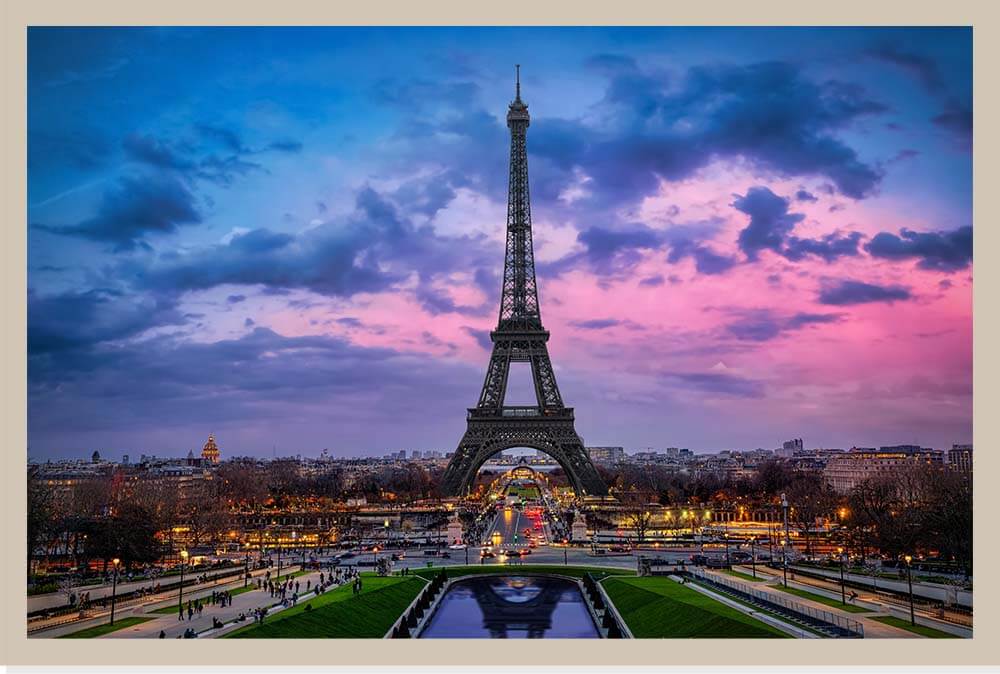
NORTHERN CENTRAL FRANCE
The City of Lights is our sixth stopover because who is traveling to France without visiting Paris.
Paris is also the city in France where I lived for the longer time from my years as a student to my first job.
Paris, Ile-de-France
Recipe: Croque-Monsieur
A quick list of all the spices Karine used in this series.
